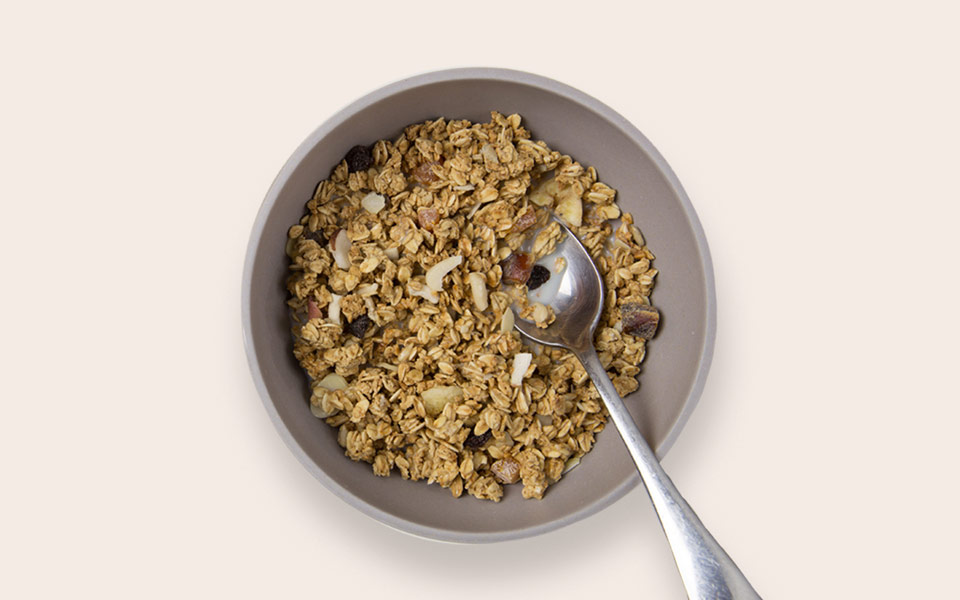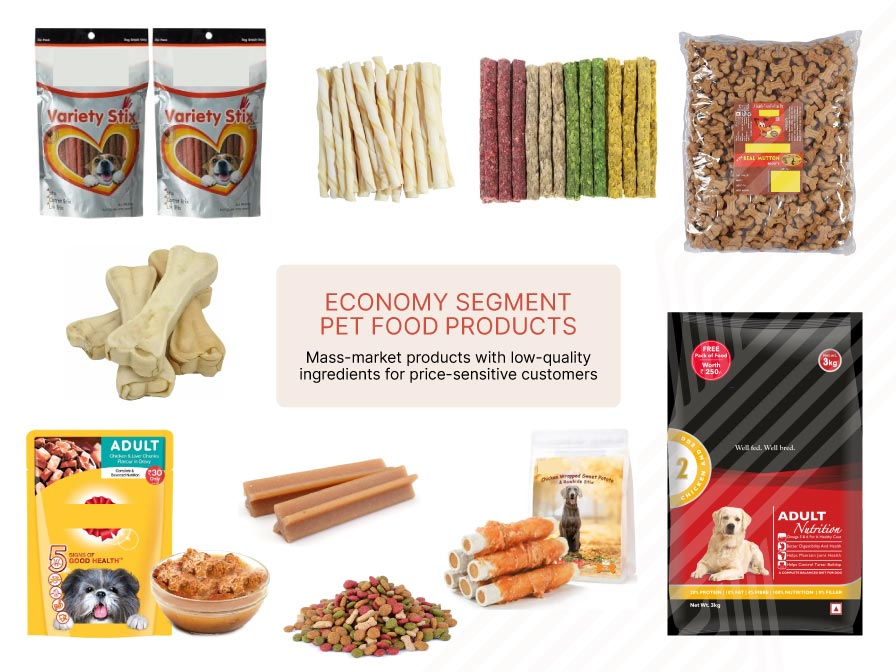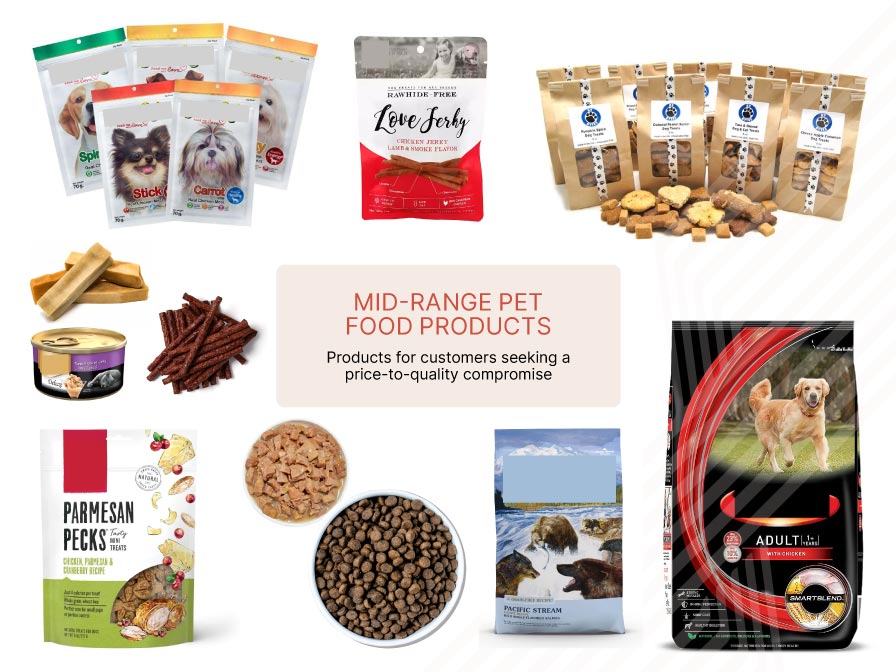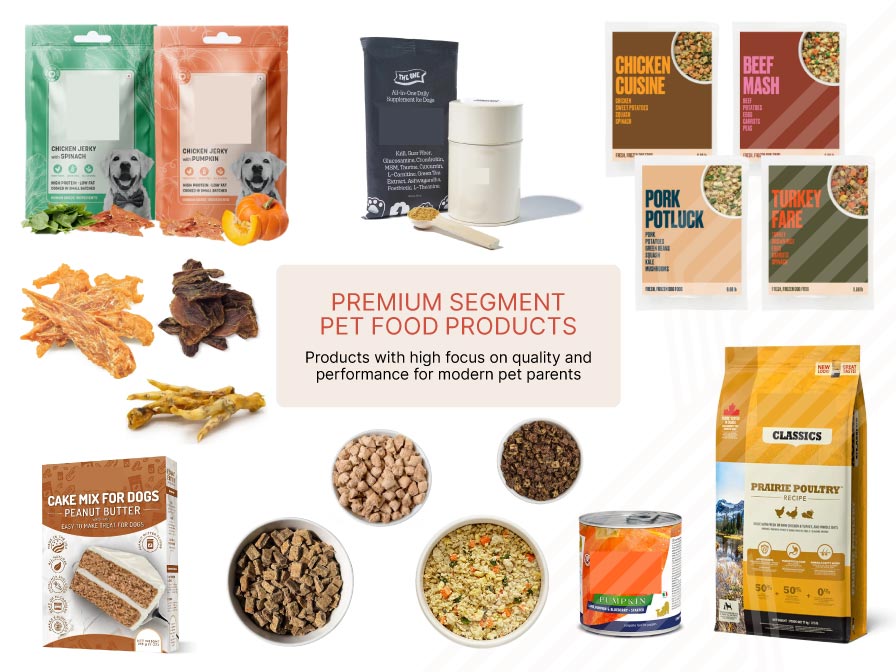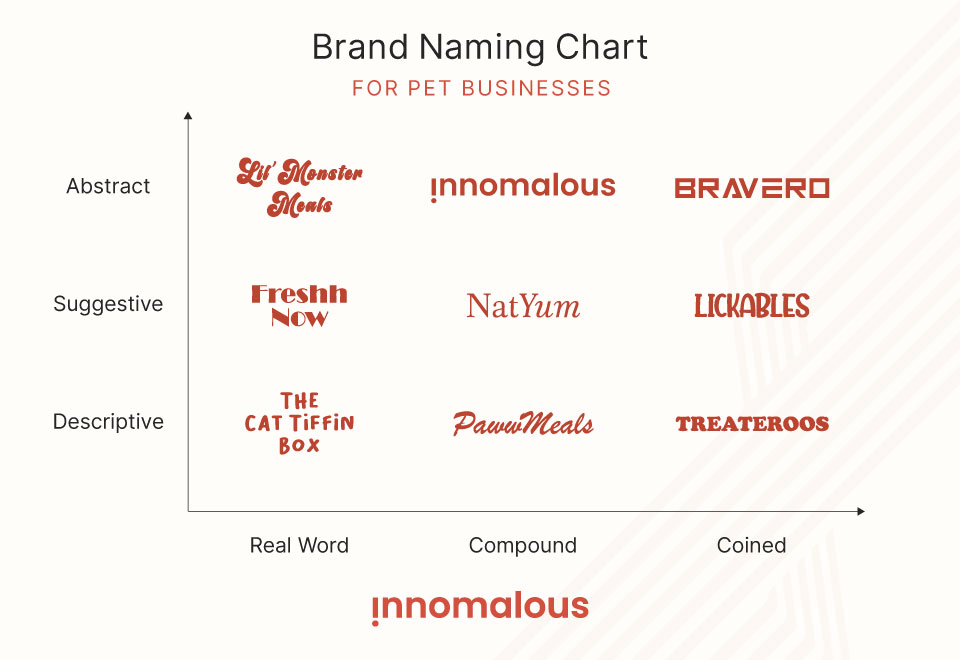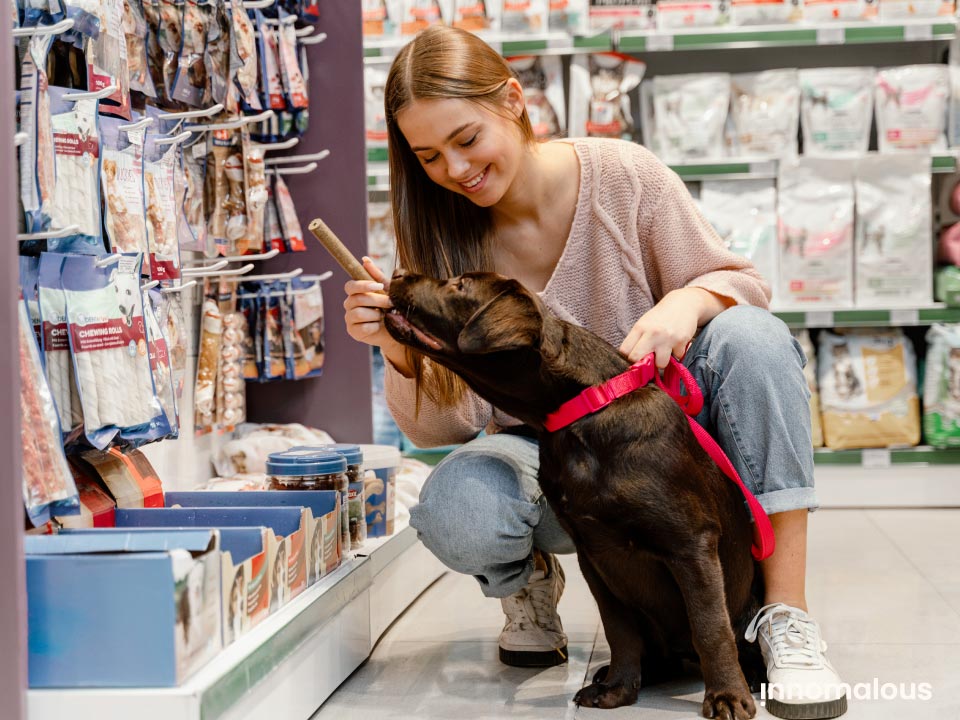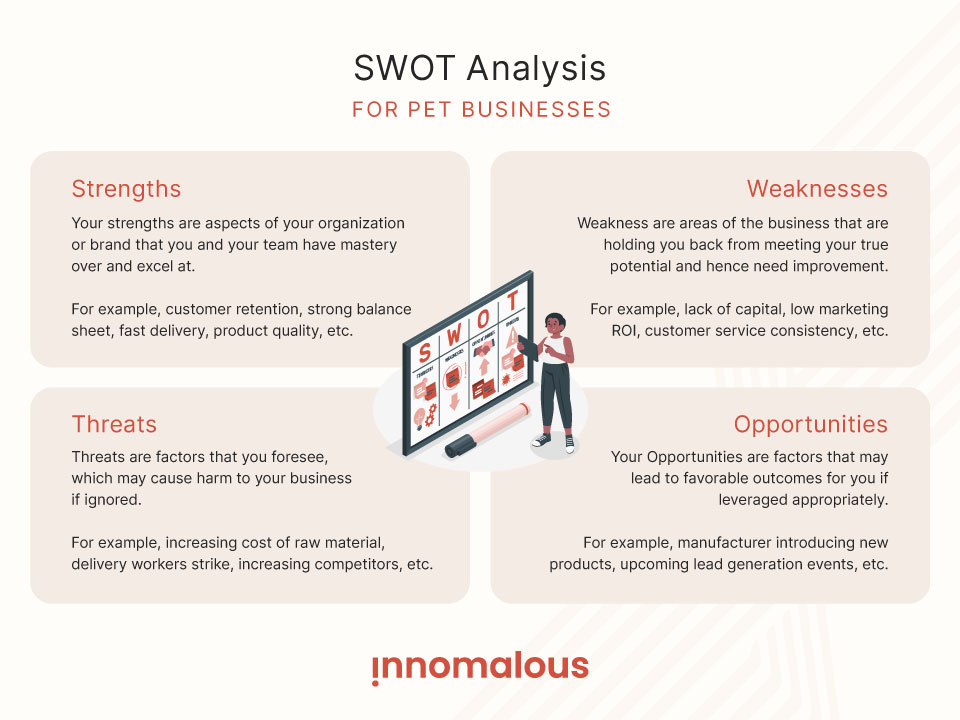Welcome to our comprehensive guide on starting and scaling a pet food business in India.
As a premium, natural pet food manufacturer, we get an insider look at the pet food industry. By combining this privilege with our expertise and experience, we have compiled valuable insights and practical advice to help you navigate the path to a successful pet food venture.
In this blog, we will explore the thriving pet food market in India, discussing market trends, growth potential, and the evolving preferences of pet parents. Whether you are a passionate pet enthusiast or an existing player in the industry, we have designed our guide to help you succeed.
We discuss all essential aspects of launching and scaling a pet food business in India, from investment requirements and profitability to product development, branding, marketing, and distribution. With our country witnessing a significant increase in pet ownership and a growing demand for high-quality pet food, now is the perfect time to enter this market.
Join us as we embark on this exciting journey into the world of pet food entrepreneurship in India. Together, let us positively impact the lives of pets and their devoted parents while building a thriving business in this dynamic industry.
Pet Industry Overview: From Necessity to Choice
The pet industry has experienced significant growth and transformation in recent years owing to various factors. We will discuss a select few below.
Industry Growth and Starting Up
The global pet food market has witnessed remarkable growth. According to Statista Market Insights, the market had a revenue of USD 143.6 billion in 2023 and is projected to reach USD 186.1 billion by 2028, growing at a CAGR of 5.32% during the forecast period of 2023-2028.
The increasing disposable income, changing lifestyles, and rising awareness about pet health and nutrition are key drivers of this growth.
India has emerged as one of the fastest-growing pet food and related products markets. It was valued at INR 28.2 billion in 2020 and is expected to grow at a CAGR of 13.9% from 2021 to 2028.
The Indian pet food industry is known for being start-up-friendly, offering opportunities for entrepreneurs to enter the market with innovative products and services.
The low entry barriers and the market acceptance to new ideas make it an attractive sector for aspiring business owners. Additionally, the strong emotional bond between pet parents and their furry companions creates a loyal customer base that most brands aspire for.
The Pet Parent Evolution
Pets have transitioned from being mere possessions to valued family members. This transformation is driven by changing societal attitudes, increased awareness about animal welfare, and the emotional bond developed between humans and their pets.

In the past, being a pet owner typically involved the bare minimum responsibilities like providing food, shelter, and essential healthcare for the pet. Pets were often seen as functional animals, serving specific purposes like security or assistance. The relationship between pet owners and their pets was primarily transactional.
However, in recent years, there has been a notable shift towards considering oneself a pet parent rather than just an owner. This shift reflects a deeper emotional connection and a more nurturing approach toward pets. Pet parents view their pets as integral members of their families, with whom they share a strong bond and emotional connection.
Pet parents now prioritize the health, well-being, and happiness of pets. They also seek high-quality, natural, and nutritious food options. This evolution in the pet parent mindset has led to the demand for specialized and premium pet food products.
COVID-19
The COVID-19 pandemic has had a profound impact on the pet industry. With lockdowns and stay-at-home orders in place, people sought companionship and emotional support, leading to a surge in pet adoptions.
Pets became adored family members, providing comfort and alleviating feelings of isolation. This increased bond between humans and pets powered industry growth during the pandemic.
Common Questions about Starting a Pet Food Business
Planning to start a pet food business can lead to a fair share of questions and uncertainties. Let us address some of the most commonly asked questions and uncover the key factors to success.
Does Starting a Pet Food Business Need High Investment?
No, starting a pet food business does not necessarily require a high investment. The pet food industry offers a relatively low entry barrier, allowing entrepreneurs to enter the market with minimal investment and disrupt from day one.
Unlike businesses that require significant real estate and workforce investment, pet food businesses can adopt a lean business model by working with a manufacturer or co-packer.
Outsourcing the production process reduces the need for expensive equipment and production facilities. This distribution saves upfront costs and allows for greater flexibility and scalability as your business grows.
Additionally, working with a manufacturer can help ensure consistent product quality and compliance with industry regulations.
Is Pet Food Business Profitable?
Yes, pet food businesses can be highly profitable for entrepreneurs who understand the market dynamics and execute their business strategies effectively.
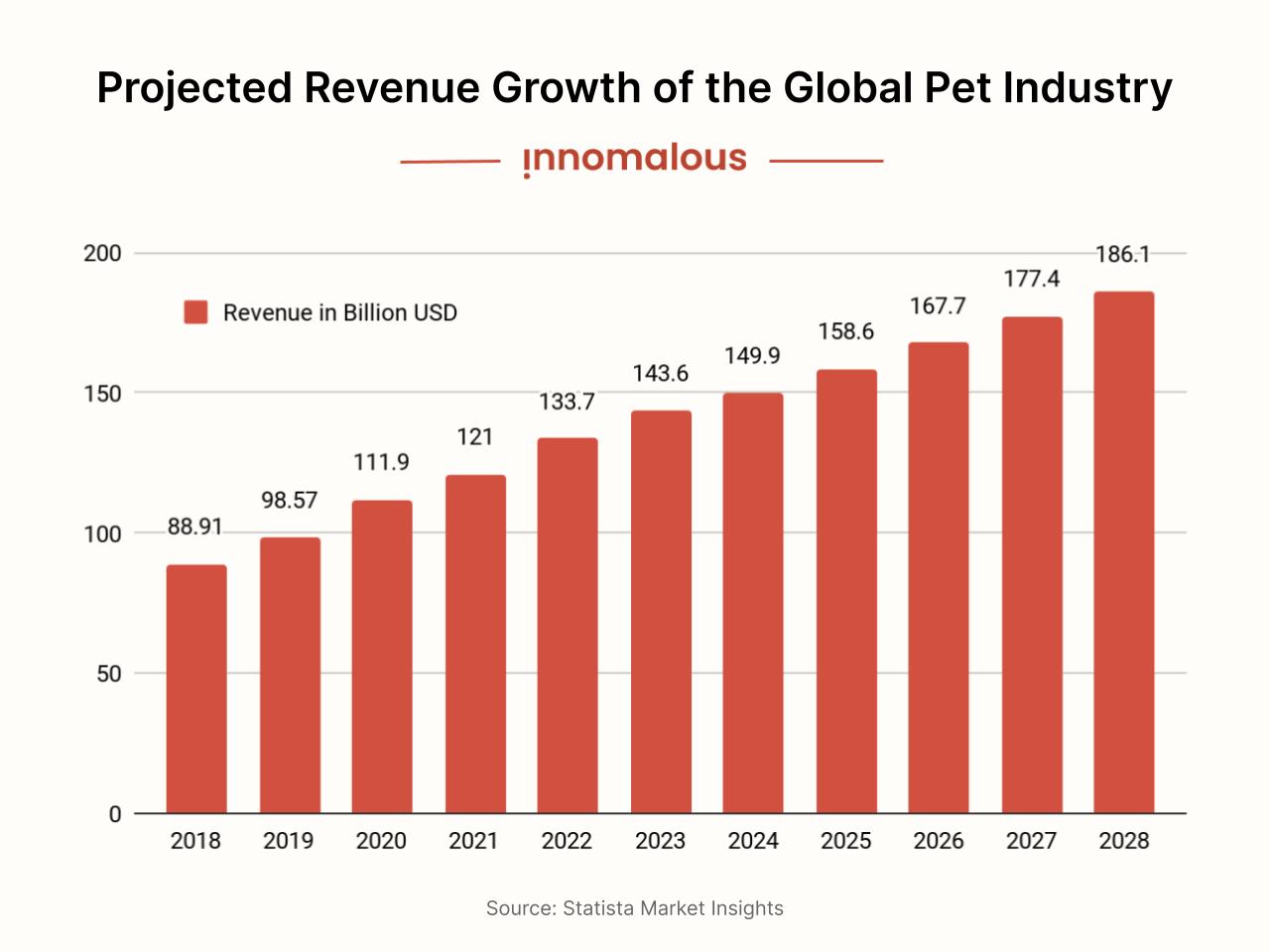
The pet food industry enjoys a receptive market, as pet parents are increasingly conscious of their pets' nutrition and well-being. With the right entrepreneurial acumen, a good team, a focus on product quality, and a commitment to delivering exceptional customer experiences, a pet food business has the potential to thrive.
Pet parents are willing to invest in high-quality pet food products that meet their pet's dietary needs. You can tap into this growing demand and build a loyal customer base by offering unique and nutritious pet food options.
However, conducting thorough market research, identifying target customers, and differentiating your products are essential in standing out in a competitive landscape.
Is the Growth Potential for Pet Food Businesses Good?
Yes, the growth potential for pet food businesses is very high owing to the significant and consistent global growth of the pet food industry.
The growing number of pets further contributes to the growth potential. As more households adopt pets, the demand for pet food continues to rise. We expect this trend to continue and present opportunities for pet food businesses to target pet parents across demographics.
The pet food market is also open to new products and innovations. Pet parents are willing to explore different options and are receptive to new offerings that cater to specific dietary requirements and preferences.
Unlike some industries dominated by monopolies, the pet food market is relatively open, allowing new entrants to capture market share.
Moreover, the pet food industry benefits from multiple sales avenues, including online platforms, pet specialty stores, supermarkets, and veterinary clinics. This diverse distribution network allows businesses to reach an extensive customer base and tap into various market segments.
Considering these factors, the pet food industry provides ample opportunities for entrepreneurs to establish and scale their businesses.
10 Compelling Reasons To Start a Pet Food Business
Starting a pet food business can be rewarding and offers significant growth potential. You can build a profitable business in the thriving pet food industry by understanding the market, meeting customer needs, and delivering high-quality products.

Growing Demand
The demand for high-quality pet foods increases as pet parents become more conscious of their pets' health and nutrition. By providing nutritious and specialized pet food options, you can cater to this growing demand.
Emotional Connection
Pets hold a special place in their parent's hearts. Pet foods are crucial to the pet's well-being. Starting a pet food business allows you to contribute to the health and happiness of pets, fostering a deep emotional connection with your customers.
Market Potential
The pet food industry is experiencing significant growth globally, with a large market size and a positive outlook. You can tap into this market potential and build a successful business with the right products and marketing strategies.
Niche Opportunities
The pet food industry offers niche opportunities to target specific segments like organic, natural, or hypoallergenic pet foods. You can differentiate your brand and attract loyal customers by identifying and catering to these niche markets.
Creative Freedom
Starting a pet food business allows you to exercise your creativity in developing unique and innovative products. You can work with a seasoned manufacturer to experiment with different flavors, ingredients, and formulations to create a distinctive brand identity.
Personal Satisfaction
For pet lovers, starting a pet food business can be personally fulfilling. It allows you to combine your passion for animals with entrepreneurship, creating a business that aligns with your values and interests.
Potential for Expansion
As your pet food business grows, there are opportunities for expansion into related product lines such as accessories, grooming, training, et cetera. This diversification can further enhance your revenue streams and brand presence.
Contribution to Animal Welfare
By providing nutritious and high-quality pet foods, you contribute to pet well-being and health in a significant way. This contribution aligns with the broader goal of promoting animal welfare and ensuring that pets live happy and healthy lives.
Flexibility and Adaptability
Working with a manufacturer allows for flexibility and adaptability in product development and scaling. You can adjust your offerings based on market trends, customer feedback, and emerging dietary requirements.
Entrepreneurial Independence
Starting a pet food business provides an opportunity for entrepreneurial independence. You can make strategic decisions, shape your brand's identity, and chart your path to success freely.
What Skills Do You Need To Start A Pet Food Business?
Several personal skills can be valuable in ensuring the growth and sustainability of a pet food startup. While specific skills may vary depending on the nature of your business, here are some essential skills to consider.
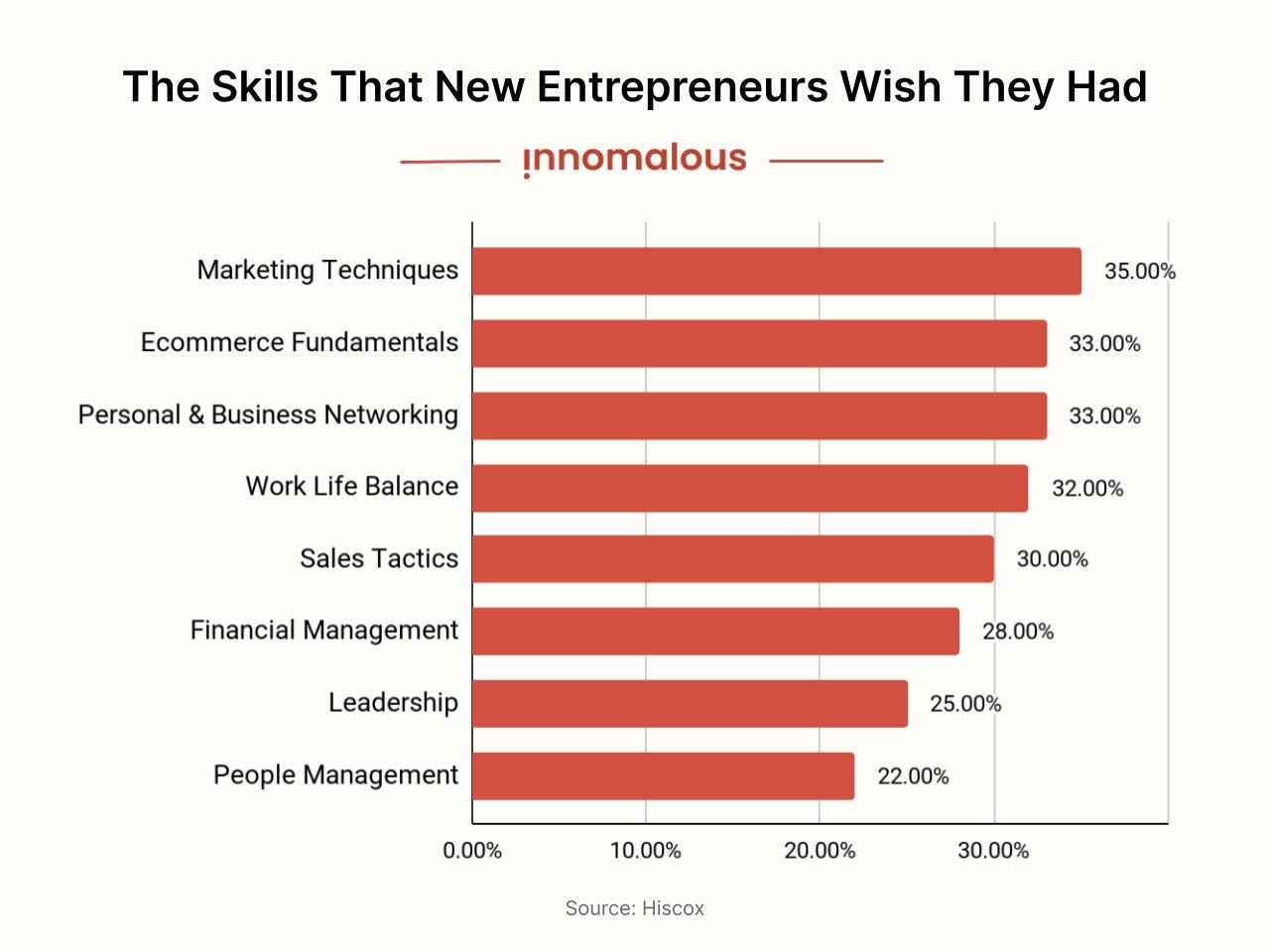
Entrepreneurial Mindset
An entrepreneurial mindset includes having qualities such as creativity, adaptability, problem-solving, and a strong drive to succeed. Entrepreneurs should be willing to take risks, learn from failures, and constantly seek growth opportunities.
Industry Knowledge
Stay updated on industry trends, consumer preferences, and regulations related to pet food production, labeling, and safety. Understanding the market dynamics and competitive landscape will help you make informed decisions and position your business strategically.
Marketing and Sales
A sturdy grasp of marketing and sales strategies is vital for promoting and selling your pet food products. This understanding should include comprehending branding, market research, identifying target customers, developing effective marketing campaigns, and building relationships with distributors and retailers.
Knowledge of digital marketing, social media, and e-commerce can also be advantageous in reaching a wider audience.
Supply Chain Management
Supply chain management is crucial for ensuring a smooth production and distribution process. As an entrepreneur, you should be able to source raw materials, coordinate with manufacturers or co-packers, manage inventory, and establish efficient logistics and distribution networks.
Customer Service
Delivering exceptional customer service cultivates strong customer loyalty and fosters favorable word-of-mouth recommendations. Knowing how to handle customer inquiries, assist in product adoption, and address concerns ensures your customers are left feeling satisfied with their engagement with your business and product.
Strong communication and interpersonal skills build healthy customer relationships and establish trust in your brand.
Financial Management
A basic understanding of financial management is pivotal for the success of any business. You need to be able to budget, forecast sales, manage expenses, and monitor cash flow.
Keeping accurate financial records and analyzing financial data to make informed decisions is paramount.
Product Development
A high-quality product helps gain customer trust and loyalty. Knowledge of pet nutrition, food science, and product formulation can help create nutritious and appealing pet food options, even in partnership with a pet food manufacturer.
Human Resource Management
As your pet food business grows, you may need to hire and manage a team of employees. Skills in human resource management, including recruitment, training, employee relations, and performance evaluation, will help build a capable and motivated team.
Having expertise in all these areas is ideal, but it is vital to recognize your strengths and weaknesses. Consider building a team or seeking assistance from professionals or consultants for the areas where you may lack prowess.
Remember, while skills are important, the intent and passion to succeed often outweigh specific skills. With a strong determination, willingness to learn, and adaptability, you can acquire the necessary skills and knowledge to start and grow a successful pet food business.
Success is a consequence of about 80% Will and only 20% Skill
Abhishek Agarwal CEO, Innomalous
Starting Your Pet Food Business: The Process
Embarking on the pet food business journey requires careful planning and execution. In this section, we will lay out a step-by-step process to guide you through the essential stages of starting your venture.

Let us delve into the process and set you on the path to launching your pet food business in India; successfully.
Step 1: Research and Planning
When embarking into the pet food industry, conducting thorough research and planning your business strategy is essential. Understanding the different types of pet food products and their respective quality and price segments is a part of this process.
Types of Pet Food Products
Pet Food & Meals
This includes complete and balanced meals designed to meet the nutritional needs of pets. It typically comes in various forms such as dry kibble, dehydrated food, or wet food.

Pet Treats & Snacks
These supplementary food items are usually smaller-sized pieces and given as rewards or for training purposes. Some popular pet treats are dog biscuits, meat jerky treats, high-value training treats, et cetera.

Pet Supplements
Pet supplements are health boosters that offer targeted solutions, addressing concerns like joint health, skin conditions, digestive well-being, et cetera. These can be in the form of powders, tablets, or even treats.

Novel Pet Foods
This category encompasses specialty or niche products, such as meal toppers, bakery items, bone broths, breakfast cereals, et cetera. catering to specific dietary requirements or pet parent preferences.

Quality and Price Segments of Pet Food Products
Economy Segment
Pros: Affordable for budget-conscious pet owners, a large potential customer base.
Cons: Contains low-quality ingredients and has limited product differentiation.
Example Products: Low-end dry kibble, “gravy” wet pet food, rawhide, bulk dog biscuits, et cetera.
Mid-Range Segment
Pros: Balanced approach between quality and affordability, broader product range.
Cons: Faces competition from both economy and premium segments.
Example Products: Well-balanced dry kibble with higher-quality ingredients, natural treats, and retort-packed fresh pet food.
Premium Segment
Pros: Emphasizes high-quality ingredients, often including unique or specialized formulas.
Cons: Higher production costs, narrower target market.
Example Products: Gourmet treats, premium kibble, rehydratable dog food, retort-packed fresh pet food.
Profit Margins on Pet Foods
Profit margins can vary depending on the segment and pricing strategy chosen.
Economy products often have lower profit margins due to competitive pricing. Mid-range to premium products can yield higher margins if positioned correctly. They also attract a loyal customer base while aiming for a balance between volume and profitability.
Analyzing the Pet Foods Market
Conducting a thorough market analysis is crucial when starting a pet food business. It provides valuable insights into the industry landscape, customer preferences, and competitive dynamics. Here is why a market analysis is beneficial and some tools and resources to help you gather the necessary information.
3 Important Reasons To Conduct a Market Analysis Before Starting Your Pet Food Business
To Identify the Target Market
Market analysis helps you understand the target customer's demographics, psychographics, and buying behaviors. This information allows you to tailor your products, branding, and marketing efforts to effectively reach and engage your audience.
To Assess the Market Size and Growth
By analyzing the overall market size and growth rate, you can determine the potential demand for pet food products and forecast future trends. This knowledge enables you to make informed decisions regarding production volumes, marketing budgets, and business expansion plans.
To Evaluate Competitors
Market analysis helps you identify your direct and indirect competitors, their product offerings, pricing strategies, and market positioning. Understanding the competitive landscape allows you to differentiate your business, identify unique selling propositions, and capitalize on untapped market opportunities.
5 Essential Tools To Conduct a Thorough Market Analysis
Industry Reports
Access industry reports from reputable market research firms that provide in-depth analysis of the pet food market, including market size, growth rate, trends, and key players.
Online Surveys and Questionnaires
Conduct surveys or questionnaires targeting pet parents to gather insights into their preferences, purchasing habits, and satisfaction levels with existing pet food products.
Social Media Listening
Monitor social media platforms to gauge customer sentiment, identify emerging trends, and gather feedback on existing products in the market.
Government Data
Utilize government databases and statistics to understand pet ownership trends, veterinary services, and related industry information.
Trade Associations, Communities, and Groups
Join pet industry associations, forums, communities, and social media groups to network with fellow professionals, gain industry insights, and access relevant resources.
Conducting a Constructive Pet Food Industry Competitor Analysis
By studying your competitors, you can learn from their successes and failures and develop strategies to position your pet food business for success in a cut-throat industry.
Competitor analysis helps you make informed decisions, refine your product offerings, and create a unique value proposition that sets your business apart from others in the market.
6-Step Effective Competitor Analysis Process To Create a Successful Pet Food Businesses Plan
Identify Competitors
Research and identify other pet food brands operating in your chosen market segments. Analyze their product offerings, pricing, packaging, and positioning.
Assess Marketing Strategies
Evaluate the marketing tactics used by your competitors, including their online presence, social media engagement, content marketing, and advertising campaigns.
Locate Distribution Channels
Analyze how your competitors distribute their products- through retail stores, e-commerce platforms, or partnerships with pet specialty shops. Assess the effectiveness of their distribution networks and explore alternative distribution channels.
Examine Customer Feedback
Study customer reviews, testimonials, and feedback on competitor products to understand customer preferences, pain points, and areas for improvement. Identify gaps or common complaints in the market and develop strategies to address these needs through product formulation, packaging, or customer service.
Recognize Gaps and Niches
Identify underserved areas within the pet food market that your competitors may have overlooked. Locate gaps and avenues where customer demands remain unmet. Catering to these niche markets can provide you with a competitive advantage.
Establish Differentiation
Determine how your brand and products can stand out from the competition. You can establish this individuality through unique product features, distinctive brand language, add-on services, or other exclusive qualities.
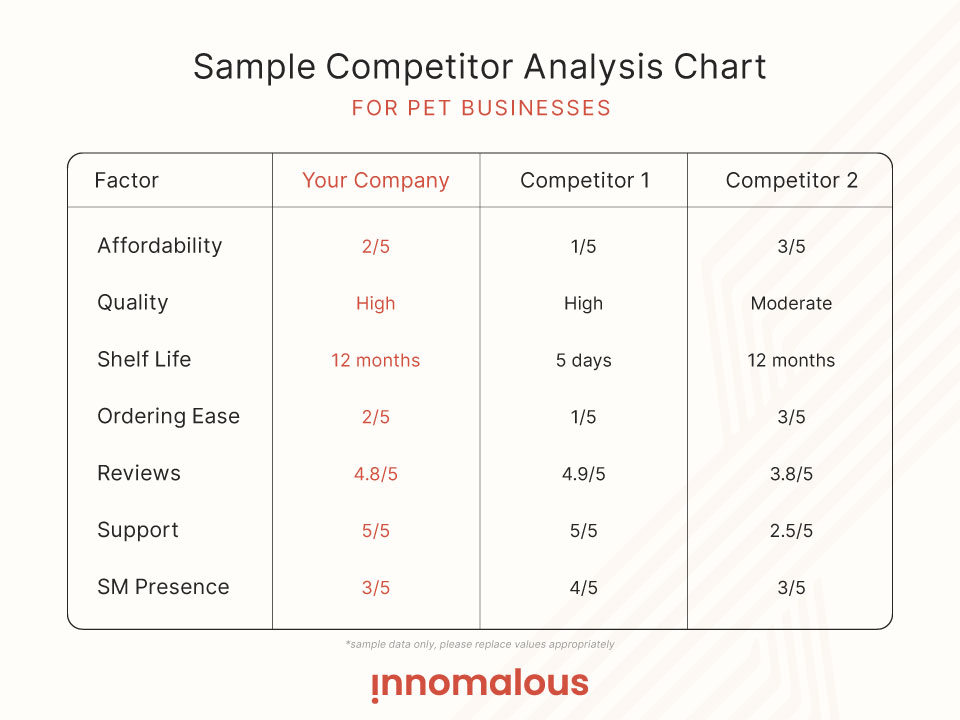
A comprehensive competitor analysis should be a part of your research. At the end of your study, you should have real insight into the relevant past and existing pet food businesses. Through this learning, you can prepare your brand’s identity with the highest potential for success.
Step 2: Creating Your Pet Food Brand Identity
Consistency and authenticity across all brand touchpoints establish a clear, compelling, and trusted brand. Putting together a brand identity before your launch will help you have guidelines to refer to for all your brand communication.
These are six key elements that your brand identity should have at this point.
Brand Vision
Your brand's vision serves as the guiding force behind your pet food business. It defines your long-term goals, aspirations, and the impact you want to make in the industry.
Consider what drives your passion for pet nutrition and what unique value you aim to bring to pet parents' lives. A compelling vision will inspire your team, attract like-minded customers, and set the foundation for your brand's growth.
Narrative and Brand Story
Craft a captivating brand narrative that tells your story and emotionally connects with your target audience. Share the inspiration behind your brand, your journey, and the values that drive you.
Your narrative should communicate why your pet food products are unique and how they contribute to the overall well-being and happiness of pets. A brand narrative helps build trust, loyalty, and a sense of authenticity with your customers.
Target Audience
Identifying and understanding your target audience is crucial for effective branding. Define the specific demographics, psychographics, and behaviors of the pet parents you aim to serve. Consider factors such as their lifestyle, preferences, and concerns related to pet nutrition.
Your brand messaging, product offerings, and marketing strategies should resonate with this audience, their needs, and their aspirations. Understanding your target audience helps you build stronger connections and deliver relevant solutions.
Retail Price Segment
Determining the appropriate retail price segment for your pet food products requires a careful balance between profitability and customer affordability.
Consider factors such as ingredient quality, production costs, target audience, and customer perceived value. Craft a pricing strategy that aligns with your brand positioning and allows you to achieve sustainable growth.
Brand Name
Choosing a memorable and meaningful brand name is essential for creating a notable identity. Your brand name should be unique, easy to pronounce, and reflective of your brand's personality and values.

Brainstorm options that convey the essence of your pet food business and appeal to your target audience. Conduct a thorough trademark and domain name search to ensure the availability of your chosen name and secure the rights to use it exclusively as soon as possible.
Visual Brand Identity
Developing a cohesive visual brand identity helps your pet food business stand out visually and create a lasting impression. At this stage, you would need only the basics. We recommend starting with the following and building as you go.
- Design a logo that encapsulates your brand's essence and resonates with your target audience.
- Select fonts and colors that align with your brand personality and evoke the desired emotions.
Each brand element contributes to building brand recognition, connecting with customers, and differentiating yourself in a competitive market. By elaborating on your identity early in the process, you will lay a strong foundation for your pet food brand.
Step 3: Company & Tax Registration and Bank Account
Registering your company and opening a bank account legitimizes your pet business so you can conduct your business activities lawfully from day one.
Choosing a Business Structure and Registering a Business Entity
You have several options when registering your pet business in India, including sole proprietorship, partnership, limited liability partnership (LLP), and private limited company.
Here are the key differences between these types of business registrations.
Sole Proprietorship
Registration: Sole proprietorship is the simplest business registration format, requiring no specific registration. A single person owns and operates this business.
Liability: The owner has unlimited liability, meaning their personal assets are at risk in case of any business debts or legal penalties.
Control: The proprietor retains full authority over all aspects of business operations and strategic decision-making.
Partnership
Registration: Partnership firms can be registered or unregistered. It is advisable to register the partnership with the Registrar of Firms. A partnership agreement is typically drafted to outline the terms and conditions of the partnership.
Liability: In a partnership, the partners share the liabilities and debts of the business. Each partner's personal assets are at risk to cover business obligations.
Control: The partners jointly manage and make decisions for the business as per the terms of the partnership agreement.
Limited Liability Partnership (LLP)
Registration: LLP registration requires filing an application with the Ministry of Corporate Affairs (MCA). It offers a legal structure combining elements of partnerships and private limited companies.
Liability: LLP offers limited liability to its partners, protecting their personal assets. Individual partners are not held personally liable for the debts or misconduct arising from other partners' actions.
Control: LLPs are managed and operated by designated partners responsible for business management and compliance with legal requirements.
Private Limited Company
Registration: Private limited companies require registration with the Registrar of Companies (ROC) under the Companies Act. The process involves drafting a memorandum and articles of association and fulfilling other legal requirements.
Liability: Shareholders are liable only up to the extent of their investment in the company. Personal assets are not at risk to cover company debt.
Control: Directors appointed by the shareholders manage Private Limited companies. Shareholders have voting rights based on their shareholding.
The choice of business registration depends on various factors- the scale of your pet food business, the level of liability protection desired, tax considerations, long-term plans, and compliance obligations.

It is advisable to consult with a legal professional or chartered accountant to understand the specific requirements and implications of each business structure and choose the most suitable option for your pet food startup.
This professional should also be able to assist you with registering your business entity under the chosen business structure.
Opening a Bank Account For Your Pet Food Startup in India
The bank account opening process should start with identifying the right bank for your business. Research and identify banks that offer relevant services and facilities. Consider banking fees, accessibility, online banking options, and additional services that may benefit your business.
The next decision you need to make is choosing the right account type. Here are the common types of accounts you can consider.
Current Accounts
Purpose: Current accounts are designed for day-to-day business transactions and are suitable for businesses with frequent banking activities.
Features: Current accounts typically offer unlimited transactions, checkbooks, overdraft facilities, and the ability to make and receive payments easily.
Usage: These accounts are ideal for managing cash flow, paying suppliers, receiving customer payments, and conducting various business transactions.
Savings Accounts
Purpose: The primary intention for savings accounts is personal savings and earning interest on deposited funds.
Features: Savings accounts generally have lower transaction limits compared to current accounts. They often provide interest on the account balance, although the interest rates may vary.
Usage: While savings accounts may not be designed specifically for business purposes, small pet food startups with minimal banking activities or who want to earn some interest on their funds can opt for them.
Specialized Business Accounts
Purpose: Specialized business accounts are tailored to meet the unique needs of businesses and offer specific features and benefits.
Features: These accounts may provide additional services such as merchant services, payment gateways, online banking tools, business credit cards, and specialized customer support.
Usage: Specialized business accounts are suitable for pet food startups that require more advanced banking services, such as accepting online payments, managing multiple currency transactions, or accessing business-specific financial tools.
When choosing the type of bank account for your pet food startup, consider the nature of your business, the volume of transactions you anticipate, your cash flow requirements, and any specialized banking services that would benefit your operations.
We suggest consulting with different banks to understand their account offerings and fees and select an account that aligns with your business needs and financial goals.
Registering for Goods and Services Tax (GST) For Your Pet Food Business
GST registration is a requirement for most businesses in India, including pet food startups.
GST, which stands for Goods and Services Tax, is a comprehensive indirect tax applied to the provision of both goods and services. It has replaced indirect taxes like VAT, excise duty, and service tax, simplifying the tax structure.
Pet foods (HSN 23091000) fall under 18% GST.
As per the GST Act, businesses engaged in the supply of goods or services with an annual turnover exceeding the threshold limit are required to register for GST. The threshold limits are as follows:
- For businesses in most states: Annual turnover of Rs. 40 lakhs or more.
- For businesses in special category states: Annual turnover of Rs. 20 lakhs or more.
Additionally, businesses that wish to ship their products to states other than their own also require a GST. Interstate movement of goods without GST can be challenging.
Most e-commerce and courier aggregation websites disallow listing or limit shipping to within the state for a business not registered under GST.
Benefits of GST Registration for Pet Food Startups:
Legitimate Business Operations
GST registration establishes the legality of your business and enables you to carry out operations without any legal issues.
Input Tax Credit (ITC)
With GST registration, you can claim ITC on the GST paid for raw materials, ingredients, packaging materials, and other business-related expenses. This aids in diminishing the overall tax burden.
Compliance with Law
GST registration ensures compliance with tax laws and avoids penalties for non-registration or non-compliance.
Business Expansion
Many businesses prefer to deal with GST-registered vendors, which can help you expand your customer base and establish credibility in the market. It can also enable you to work with vendors across geographies at scale.
To initiate GST registration, adhere to the following steps:
- Visit the GST portal and navigate to the 'New Registration' section.
- Fill in the necessary details, including business information, owner/partner details, bank account information, and address proof.
- Submit the required documents, such as PAN card, Aadhaar card, bank statements, proof of address, and photographs.
- Once the application is submitted, a GST officer will review the application and may seek additional information if required.
- Upon approval, you will receive a unique GSTIN (Goods and Services Tax Identification Number) for your business.
A tax professional or GST expert can help ensure accurate GST registration and compliance for your pet food startup. They can guide you through the process, help you understand the applicable GST rates and regulations for pet food products, and ensure that your business remains GST-compliant at all times.
Step 4: Figuring Finances and Initial Funding
As you set up your pet food startup, it is good to know that managing finances and taking important financial decisions are going to be an everyday reality. Getting comfortable, confident, and intentional with this decision-making is fundamental.
By prioritizing financial planning, securing adequate funds, and setting up a reliable accounting system, you can establish a financial foundation for your pet food startup.
Planning and Budgeting Finances for Your Pet Food Business
Before launching your pet food startup, we highly suggest thorough financial planning and budgeting.
Start by identifying the various costs involved in starting and running your business. Consider expenses such as product development (ingredients, recipes, formulation), infrastructure setup (rent, utilities, equipment), employee salaries and benefits, marketing and advertising campaigns, packaging materials, and other operational costs.
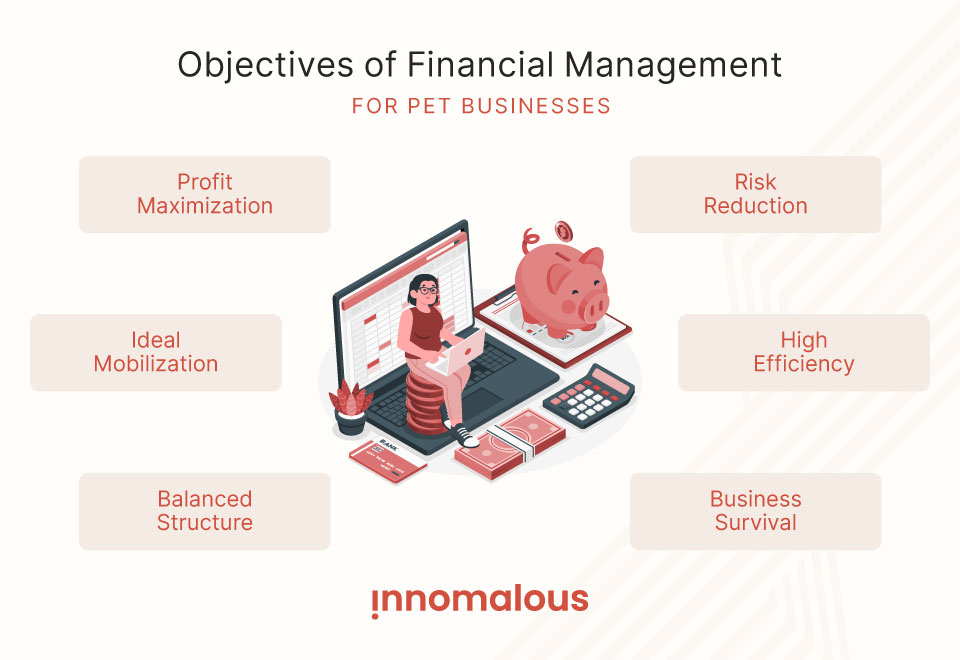
Create a detailed budget that allocates funds to each area, considering both one-time startup costs and ongoing expenses. This planning will help you estimate the financial requirements and ensure you have adequate funds to support your business operations.
Raising Initial Funding for Your Pet Food Startup
Your initial funding can be the fuel to help your new pet food business take off. Evaluate your financial needs and consider different fundraising options available to you.
Funding From Savings, Friends, and Family
Self-funding through personal savings or contributions from friends and family is a common approach for early-stage startups.
Funding From Bank Loans
You can explore the option of bank loans, where you will need to present a solid business plan and financial projections to convince lenders of the viability of your venture.
Funding From Investors
Attracting potential investors interested in the pet food industry can provide you with the necessary capital. This process typically involves pitching your business idea, demonstrating market potential, and showcasing your unique value proposition to convince investors of the profitability and growth potential of your pet food startup.
We also suggest looking up government funding for women-led, indigenous, and innovative businesses.
Prioritizing financial planning and securing adequate funds will allow you to make informed decisions and drive sustainable growth.
Setting Up Accounting for Your Pet Food Startup
Establishing a robust accounting system enables you to track income, expenses, and cash flow, ensuring you have a clear understanding of the financial health of your business.
Consider the following steps for setting up accounts.
Select an accounting software
Utilize free accounting tools available online or consider investing in professional accounting software that suits the needs of your business. These tools simplify financial tasks, such as invoicing, expense tracking, and financial reporting.
Establish financial processes
Develop standardized processes for recording transactions, invoicing customers, managing expenses, and reconciling accounts. This structure ensures consistency and accuracy in your financial records.
Track income and expenses
Regularly record all income and expenses related to your pet food business. Categorize transactions appropriately, such as ingredients, packaging, marketing, and employee salaries, to gain insights into your spending patterns and profitability.
Monitor cash flow
Keep a close eye on your cash flow to ensure you have sufficient funds to meet your financial obligations and cover operational expenses. Cash flow management helps with maintaining the financial stability of your pet food startup.
Implementing a reliable accounting system will enable you to make informed decisions, monitor your financial performance, and navigate the financial aspects of your startup effectively.
Step 5: Product and Infrastructure Development
When starting a pet food brand, developing the necessary product and infrastructure is the step that brings your vision to life. This step entails creating high-quality pet food products that meet the nutritional needs and preferences of pets and establishing the infrastructure required for efficient production, storage, and distribution.

This section delves into product development and infrastructure setup aspects essential for a successful pet food business. By focusing on these foundational elements, you can ensure that your brand delivers exceptional products while operating seamlessly to meet the demands of the market and pet owners.
White-Labeling vs Manufacturing Pet Foods For Your Startup
When it comes to product development for your pet food business, you have two main options: sourcing products from a reliable pet food manufacturer or manufacturing them yourself.
These are some advantages of sourcing from a manufacturer and why it can be a favorable choice for many startups.
Ease and Low Capital Investment
Sourcing products from a reputable pet food manufacturer allows you to bypass the complexities and costs of setting up your manufacturing facility.
You can leverage the expertise and infrastructure of the manufacturer, saving you from the hassle of acquiring machinery, hiring specialized staff, and dealing with regulatory requirements. These savings significantly reduces your initial capital investment and allow you to focus on other crucial aspects of your business.
Innomalous offers a wide catalog of products pre-formulated to reduce time to market and R&D costs when starting up.
No Training or Machinery Required
You eliminate the need for extensive training programs or expensive machinery by partnering with a pet food manufacturer. They already possess the necessary knowledge, skills, and equipment to produce high-quality pet food products.
You can enter the market quickly and efficiently without the need to navigate the complexities of manufacturing processes.
No Liabilities or Maintenance Costs
Manufacturing your pet food products involves assuming various liabilities and maintenance costs. These include product quality control, regulatory compliance, equipment maintenance, and facility upkeep.
By sourcing from a reliable manufacturer, you transfer these responsibilities to them, allowing you to focus on other critical areas of your business, such as marketing, distribution, and customer satisfaction.
Flexibility to Pivot and Scale
Working with a dependable manufacturer frees you to adapt, adjust, and pivot your product offerings as market demands and trends evolve.
If you decide to introduce new flavors, formulas, or variations, the manufacturer can swiftly accommodate these changes without significant infrastructural adjustments at your end.
As your business grows scaling production becomes easy with a manufacturer as they can accommodate larger order volumes.
Low Time to Market and Quality Consistency
Choosing to source products from a reliable pet food manufacturer significantly reduces your time to market. Manufacturers have established production processes, allowing for efficient and timely production of pet food products.
Moreover, partnering with a reputable manufacturer ensures consistent quality control. Strict quality assurance measures make sure industry standards and regulations are maintained. This control helps you deliver consistent and reliable products to your customers, building trust and loyalty.
Private-labeling pet food products from a reputable manufacturer lets you leverage their expertise, infrastructure, and industry knowledge while minimizing your upfront costs and operational complexities. This approach allows you to focus on building your brand, developing marketing strategies, and delivering high-quality products to pet owners across India.
Packaging and Labeling Your Pet Foods Products in India
The packaging of a product serves multiple purposes that extend beyond mere aesthetics. In this section, we will explore the main goals and purposes of packaging, along with best practices for sourcing and utilizing packaging for your pet food products.
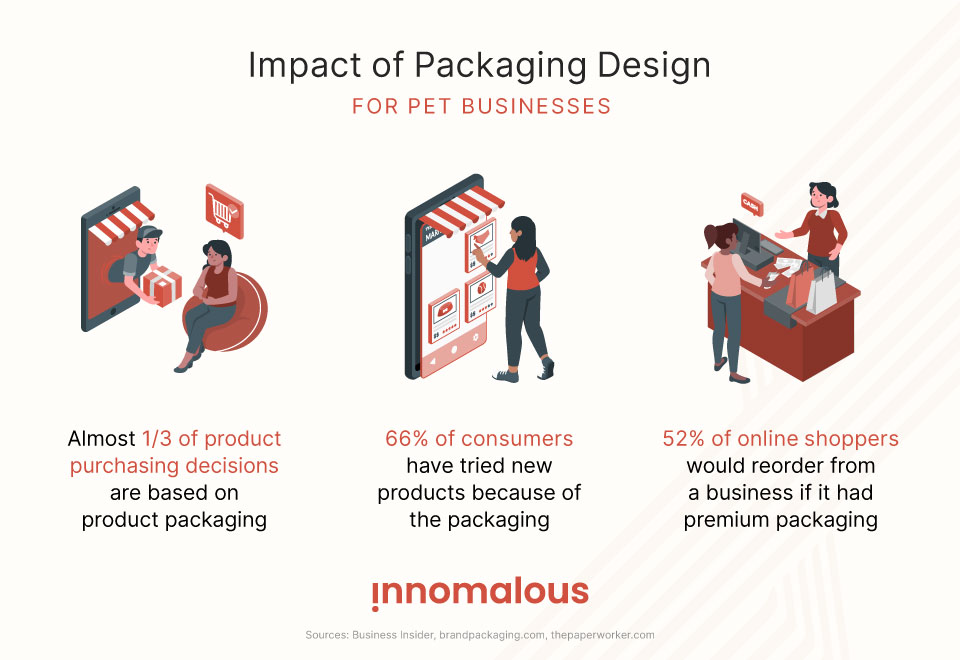
Let us start by understanding the primary goals of packaging.
Ensuring Product Safety
Packaging should provide a protective barrier to maintain the freshness, quality, and integrity of the pet food, preventing contamination and spoilage.
Enhancing Product Appeal
Packaging serves as a visual representation of your brand and product, attracting the attention of pet owners.
Conveying Product Information
Packaging should communicate important information to pet owners, including ingredients, nutritional content, feeding guidelines, and any special features or benefits.
Differentiating Your Brand
Packaging should reflect your brand's identity, values, and unique selling proposition, distinguishing your products from others in the market.
Best Practices When Sourcing Packaging for Your Indian Pet Food Brand
Selecting the right packaging for your pet food is critical for product safety, appeal, and functionality. Consider the following best practices and factors when choosing the packaging.
Compatibility with Product Makeup
Ensure that the chosen packaging material is suitable for the specific characteristics of your pet food products, such as moisture resistance, durability, and airtightness.
Size and Dimensions
Optimize the size and dimensions of the packaging to accommodate the product effectively, fit on store shelves, and minimize shipping costs. Consider the weight and volume of the product to determine the appropriate packaging size.
Customization Options
Determine if your pet food brand requires customized packaging to reflect your unique identity. Consider the minimum order quantities (MOQs) and pricing for customization to align with your budget and market demand.
Resonance with Current Products and Categorization
Ensure the packaging design aligns across your product lines, creating a cohesive and recognizable brand identity. Additionally, consider how the packaging categorizes your product accurately to aid customers in finding and identifying it.
Cost Considerations
Balance the cost of packaging with your budget. While it is essential to choose high-quality packaging, it does not always have to come at the highest price. Explore options that balance cost-effectiveness and product presentation so you can incur this cost sustainably in the long term.
Sample Testing
Always request and evaluate samples of the packaging before placing a final order. This checking allows you to assess the quality, functionality, and overall appeal and make necessary adjustments before making any financial commitments.
Ergonomics for Storage, Logistics, and Customers
Evaluate the practical aspects of the packaging, considering how it will be stored, transported, and handled by customers. Optimize for easy stacking, convenient storage, and user-friendly features that enhance the customer experience.
Sustainable and Low-Waste Design
Embrace environmentally friendly practices by designing packaging with low waste in mind. Consider recyclable, biodegradable, or compostable materials, reducing your carbon footprint and appealing to eco-conscious customers.
Consult with Food and Packaging Manufacturers
Collaborate closely with both your pet food manufacturer and packaging manufacturer. Seek their expertise to ensure that the packaging aligns with the product's requirements and meets industry regulations for food safety.
Considering these factors will help you select packaging that not only protects and presents your pet food products effectively but also aligns with your brand identity, sustainability goals, and logistical requirements.
Designing Effective Packaging for Your Pet Food Brand
Packaging design captures the attention of customers, communicates your brand's values, and influences purchasing decisions.
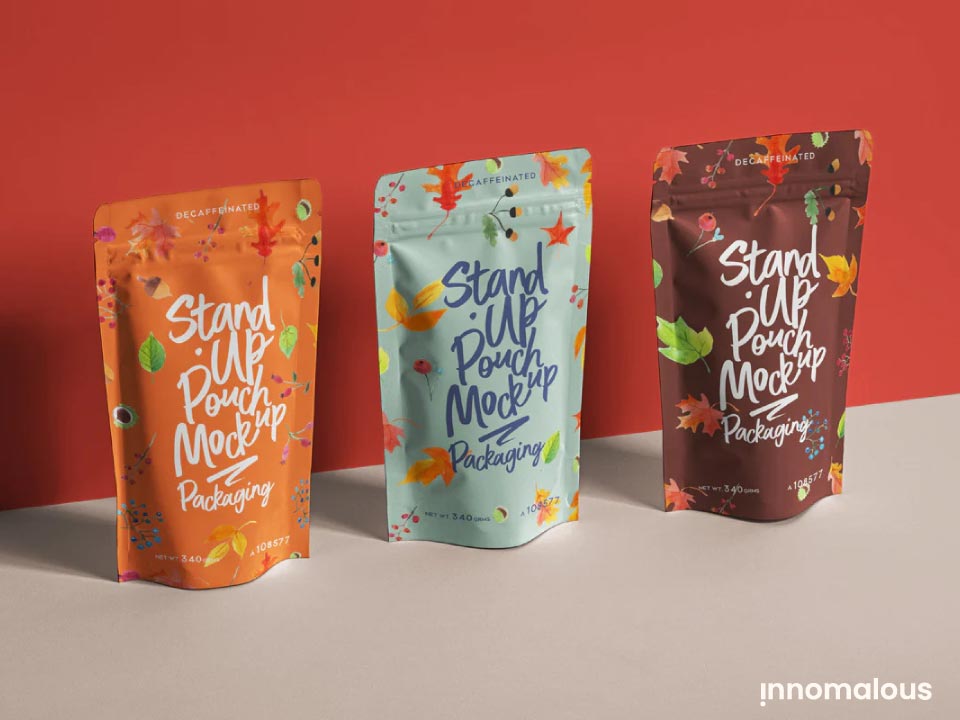
Here are some key considerations when it comes to designing effective packaging for your pet food brand.
Reflect Your Brand Identity
Your packaging should align with your brand's identity and convey its unique personality. Consider your brand values, target audience, and positioning while selecting design elements such as colors, typography, and imagery. Consistency in branding across all packaging materials helps in building brand recognition and loyalty.
Clear and Informative
Your packaging should clearly communicate important information about your pet food products. Include essential details such as the product name, flavor/variant, key ingredients, nutritional information, and any special features or benefits. Ensure that the text is legible, and the information is presented in a well-organized manner.
Eye-Catching Visuals
Use captivating visuals to make your packaging stand out on the shelves. Incorporate appealing images of pets or visually enticing illustrations that showcase the product's main ingredients or benefits. Consider the preferences and aesthetics of your target audience while choosing the visual elements for your packaging design.
Shelf Appeal and Differentiation
Your packaging design should help your pet food products stand out on the shelves and differentiate them from competitors. Consider the overall aesthetics, including color schemes, patterns, and graphic elements, to create an attractive visual presence. Conduct market research to understand the visual trends and preferences in the pet food industry, and find ways to make your packaging visually appealing and unique.
Practicality for Customers
Make sure your packaging is user-friendly and convenient for pet owners. Easy-to-open and resealable packaging options can enhance the customer experience and ensure product freshness. Consider functional features such as tear strips, pour spouts, or zip-lock closures that provide ease of use and convenience for pet parents.
Compliance with Regulations
Ensure that your packaging design meets all the necessary regulatory requirements and guidelines for pet food products. Familiarize yourself with the labeling regulations and any specific requirements for pet food packaging in India. Adhere to these guidelines to maintain legal compliance and build trust with customers.
Test and Iterate
Before finalizing your packaging design, conduct thorough testing and gather feedback from your target audience. Consider conducting focus groups, surveys, or product trials to assess customer perception and preferences. Iteratively refine your packaging design based on the insights gained from customer feedback.
Effective packaging design not only attracts customers but also reinforces the quality and value of your pet food products. Invest in professional design services or collaborate with experienced packaging designers to create packaging that captures the essence of your brand and engages pet owners.
Ensuring Safe Delivery and Customer Satisfaction with Secondary Packaging
When shipping your pet food products to customers or distributors, the integrity of the secondary packaging allows for safe delivery and provides a positive customer experience.

Typically, secondary packaging refers to the corrugated boxes or cartons that enclose and protect your products during transit. Here is why secondary packaging matters and some best practices to consider.
Product Protection
The primary purpose of secondary packaging is to safeguard your pet food products during transportation. It should provide adequate cushioning, support, and protection against external factors such as impact, moisture, and temperature changes. Choose durable and sturdy corrugated boxes that can withstand the rigors of the shipping process.
Dimensional Considerations
Optimize the size and dimensions of the secondary packaging to ensure a snug fit for your pet food products. This consideration helps prevent shifting or movement during transit, reducing the risk of damage. Efficient use of space can also minimize shipping costs by avoiding unnecessary dimensional weight charges.
Quality and Durability
Select high-quality corrugated boxes designed to withstand the handling and transportation process. Consider the material strength, the box construction, and the integrity of the seams. Sturdy secondary packaging protects the product and reflects positively on your commitment to quality at the same time.
Customization and Branding
Leverage the opportunity of secondary packaging to reinforce your brand identity. Consider printing your logo, brand colors, and other relevant information on the boxes. Customization helps create a professional and cohesive presentation while enhancing brand recognition.
Packaging Testing
Conduct thorough testing to ensure the strength and reliability of the secondary packaging. Perform drop tests, compression tests, and simulations of typical transportation conditions to verify that the packaging can withstand the demands of the shipping process. This testing phase allows you to identify and address any weaknesses or vulnerabilities in the packaging design.
Eco-Friendly Options
Explore eco-friendly alternatives for your secondary packaging. Look for recyclable or biodegradable materials to align with sustainability goals. Consider using packaging materials made from recycled content or that can be easily recycled by customers.
Clear Labeling
Clearly label the secondary packaging with important information, such as product name, quantity, batch numbers, handling instructions, addresses, and any other necessary details. This clarity helps with inventory management, ease of identification, shipping, and compliance with regulatory requirements.
Remember, the secondary packaging is the first physical interaction your customers have with your product upon delivery. By investing in reliable and well-designed corrugated boxes your product will arrive safely and provide a positive unboxing experience for your customers.
Basics of Inventory Warehousing for an Indian Pet Food Startup
As a pet food startup in India, establishing an efficient warehousing system includes managing inventory, ensuring timely deliveries, and maintaining product quality. While setting up a warehouse can seem intimidating on Day 1, you can choose to build your warehouse system gradually.
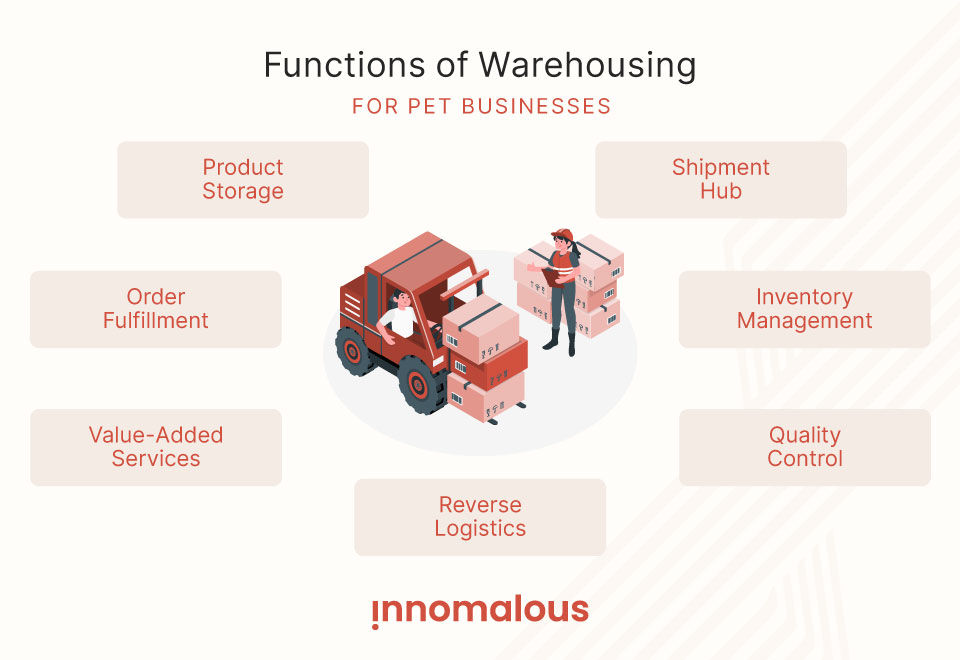
Here are some key considerations and best practices about warehousing that you should know from the start.
Space and Layout
Evaluate your warehousing needs based on the volume of inventory and projected growth. Consider factors such as storage capacity, layout efficiency, and the ability to accommodate different types of products (dry food, treats, et cetera.). Optimize vertical space utilization with racks or shelves to maximize storage capacity.
Temperature Control
Depending on the nature of your pet food products, temperature control may be crucial. Some products may require specific temperature conditions to maintain their quality and freshness. Ensure your warehouse has the necessary infrastructure, such as refrigeration or climate-controlled areas, to meet these requirements.
Pest Control
Implement effective pest control measures to prevent infestations and protect your pet food inventory. Regular inspections, proper waste management, and sealing potential entry points can help minimize the risk of pests. Consider working with professional pest control services to ensure a pest-free environment.
Organization and Labeling
Maintain a well-organized warehouse by implementing proper labeling and categorization systems. Mark storage areas, shelves, and bins to facilitate easy identification and retrieval of products. Utilize inventory management software or systems to track stock levels and ensure efficient order fulfillment.
Inventory Management
Implement robust inventory management practices to track stock levels, monitor expiration dates, and manage order fulfillment effectively. This setup includes establishing a system for receiving, inspecting, and storing incoming inventory, as well as implementing first-in, first-out (FIFO) or batch management methods to manage product expiration.
Quality Control
Regularly inspect and monitor the quality of your pet food products stored in the warehouse. Implement quality control measures to ensure that products are stored in suitable conditions, and that damaged or expired items are promptly identified and removed from inventory.
Safety Measures
Prioritize the safety of warehouse staff and ensure compliance with safety regulations. Provide proper training on handling equipment, lifting techniques, and emergency procedures. Maintain a clean and organized workspace to minimize the risk of accidents and injuries.
Scalability
Anticipate future growth and scalability when setting up your warehousing infrastructure. Plan for expansion or the ability to scale up operations as your pet food business grows. This planning may involve considering the availability of additional warehouse space or exploring partnerships with third-party logistics providers.
Effective warehousing practices ensure the smooth functioning of your pet food business. By carefully considering the above factors you can establish a reliable warehousing system that supports your operations and contributes to the success of your pet food startup.
Developing an App or Website for Your Indian Pet Food Business
In the digital age, your app or website is often the first interaction your customers have with your business. Having one is non-negotiable, and having an effective website or app can play a huge role in helping your business take off.
Should I Have a Website or an App?
Both options, website and mobile application, offer unique advantages and considerations. Before you decide which one you should go with, here is a comparison to help you make an informed decision.
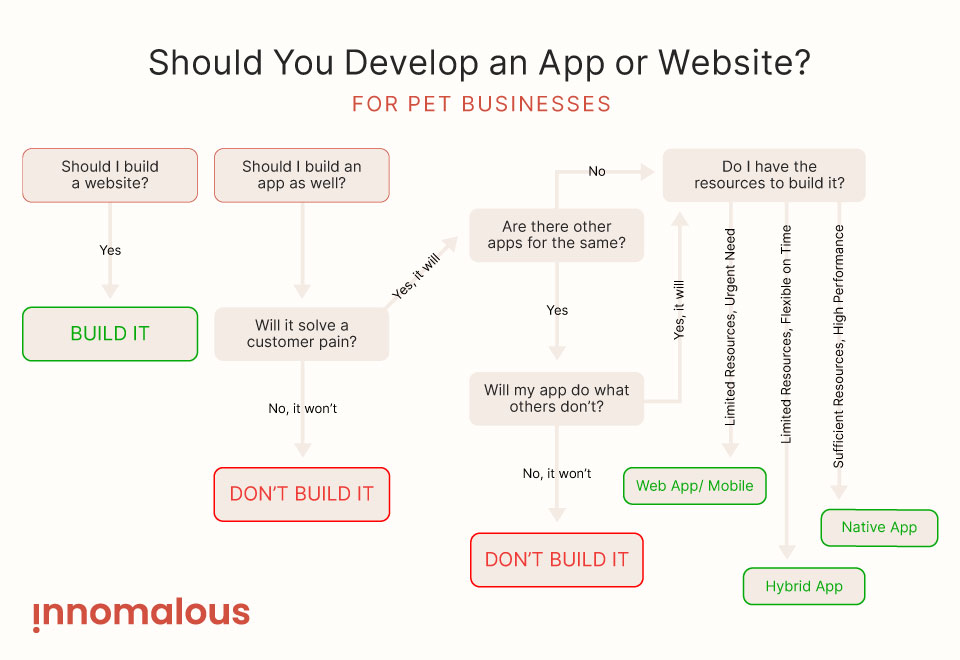
Mobile App
Enhanced User Experience
Apps can provide a more immersive and personalized user experience with features like push notifications, offline access, and device integrations.
Increased Engagement
Apps can foster strong customer engagement through interactive features, loyalty programs, and personalized recommendations.
Brand Visibility
Having an app icon on customers' mobile devices serves as a constant reminder of your brand.
Performance Optimization
Apps can leverage device capabilities, such as camera access or GPS functionality, to deliver specialized features and improved performance.
Targeted Marketing
Apps allow you to gather user data and behavior insights, enabling you to implement targeted marketing strategies.
Website
Accessibility
Websites can be accessed on any device with an internet connection, reaching a wider audience than mobile apps.
Cost-Effective
Developing a website is generally more cost-effective than building a mobile app, as it does not require separate development for different platforms.
Search Engine Visibility
Websites are more easily discoverable through search engines, helping to attract organic traffic and expand your customer base.
Cross-Platform Compatibility
Websites offer a consistent user experience across different devices and platforms.
Flexibility and Updates
Websites allow for easier and faster updates to content and functionality compared to app updates, which may require user downloads and installations.
Consider the nature of your business, target audience, and specific goals when deciding between an app and a website. In many cases, having both can complement each other and provide a comprehensive online presence.
It is essential to assess your resources, budget, and long-term strategy to make the best choice for your pet food startup in India.
A 12-Step Guide To Developing a Powerful App or Website for Your Pet Food Startup
A well-designed website or app is a powerful tool to showcase your products, engage with customers, and drive sales. Use our comprehensive guide on developing a website or app for your pet food startup, tailored to the Indian market to get started.
Step 1: Define Your Goals and Objectives
Before starting the development process, clearly define your goals and objectives for the website or app. Consider what you want to achieve, such as increasing brand awareness, driving online sales, providing product information, or facilitating customer engagement.
This clarity of goals will help guide the development process and ensure alignment with your business objectives.
Step 2: Choose the Right Platform
For a website, you can choose between content management systems (CMS) like WordPress or custom development. When it comes to apps, you can opt for native development (iOS and Android) or cross-platform frameworks like React Native or Flutter.
Evaluate the pros and cons of each option based on your specific requirements, budget, and technical expertise.

Step 3: Prioritize User-Centric Design
Create a user-centric design that is visually appealing, intuitive to navigate, and optimized for a seamless user experience. Consider the preferences and behavior of your target audience when designing the layout, menu structure, and overall user interface.
Incorporate high-quality product images, clear product descriptions, and intuitive navigation to enhance user engagement and drive conversions.
Step 4: Optimize for Mobile Responsiveness
Implement responsive design principles to ensure a consistent and user-friendly experience across different screen sizes and devices.
Device responsiveness will allow your customers to access and interact with your pet food products conveniently, whether browsing on a desktop, smartphone, or tablet.
Step 5: Setup Product Catalog and Ordering
Develop a comprehensive product catalog that showcases your range of pet food products. Include detailed information about each product, such as ingredients, nutritional value, and any specific benefits or features.
Implement an easy-to-use ordering system that allows customers to add products to their cart, choose quantities, and proceed to checkout seamlessly.
Step 6: Integrate Payment Gateways and Secure Payments
Ensure a seamless and secure payment process for your customers by integrating reliable payment gateways into your website or app. Choose payment gateway providers that are popular and trusted in the Indian market, such as Paytm, Razorpay, or Instamojo.
Implement secure payment protocols, such as SSL encryption, to protect sensitive customer information during transactions. Provide multiple payment options, including credit/debit cards, net banking, and digital wallets, to cater to varied customer preferences.
Regularly monitor and test your payment gateway integration to ensure smooth and error-free transactions.
Step 7: Add Customer Reviews and Ratings
Incorporate a customer review and rating system to build trust and credibility. Enable customers to leave feedback and ratings for the products they have purchased.
Displaying positive reviews and testimonials can significantly influence purchasing decisions and encourage potential customers to choose your pet food brand. Responding to customer reviews promptly also shows your commitment to customer satisfaction.
Step 8: Integrate Social Media
Integrate social media buttons and sharing options to enable easy social media sharing for customers. Connect your website or app with your social media accounts to foster a cohesive brand presence and allow customers to engage with your brand on multiple platforms.
This connectivity also provides user-generated content and social proof opportunities, enhancing your brand's visibility.
Step 9: Setup Customer Support and Feedback Mechanisms
Include accessible customer support options on your website or app. Provide channels for customers to reach out with inquiries, concerns, or feedback. Offer live chat support, email support, or a dedicated customer support helpline to address customer queries promptly and efficiently.
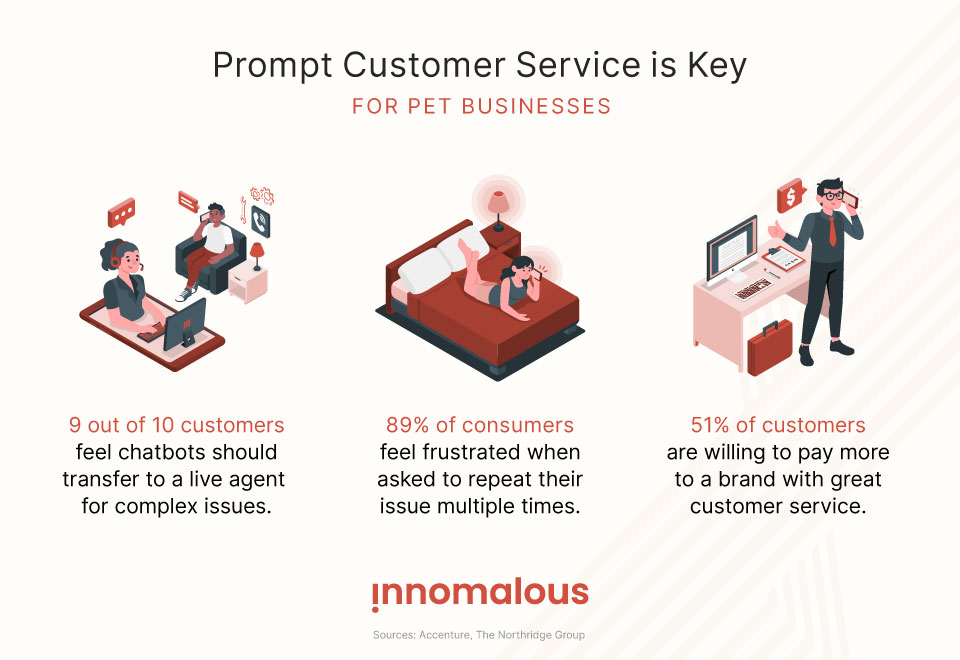
Collect and analyze customer feedback to continually improve your products and services.
Step 10: Ensure Good Performance and Security
Ensure your website or app performs optimally and provides a secure browsing and purchasing experience. Regularly monitor and optimize the page loading speed, implement caching mechanisms, and optimize images to minimize load times.
Implement robust security measures, like SSL encryption, to protect customer data and instill trust.
Step 11: Optimize for Search Engines
Incorporate SEO best practices to enhance your website's prominence within search engine results. Conduct thorough keyword research and optimize your content, meta tags, headings, and URLs to harmonize with search inquiries.
Develop a content strategy that includes informative and engaging blog posts, articles, and pet care tips to attract organic traffic and establish your brand as an industry authority.
Step 12: Track, Analyze, and Leverage Website/App Data
Integrate website analytics tools such as Google Analytics to gather insights into user behavior, website traffic, conversion rates, and other key performance indicators. Leverage this data to make data-driven decisions, identify areas for improvement, and refine your marketing strategies.
By following these guidelines, you can develop a website or app that effectively showcases your pet food products, engages your target audience, and drives business growth in the Indian market. Remember to continuously monitor and optimize your online presence to adapt to evolving customer needs and stay ahead of the competition.
Should You Outsource Web Development for Your Pet Food Startup?
If developing a website or app is not your expertise, outsourcing the task can be viable. Hiring a freelancer for website development can lead to cost savings, time efficiency, and an overall better quality product.
Conduct thorough research and evaluate potential outsourcing partners based on their experience, portfolio, client reviews, and overall reputation. Discuss post-development support and maintenance services with the outsourcing partner to ensure ongoing assistance after the website or app launch.
Regularly engage with the outsourcing team, provide feedback, and monitor progress to ensure the final product aligns with your vision and objectives.
Establishing Social Media Presence for Your Pet Food Business
Today, social media has become an integral part of marketing strategies for businesses of all sizes. When it comes to your pet food startup, effectively leveraging social media can help you connect with your target audience, build brand awareness, and drive engagement.

Here is how you can create and manage social media accounts for your pet food startup in India.
Choosing the Right Social Media Platforms
To make the most of your social media activity, choose the platforms that align with your business goals and target audience. Conduct thorough research to understand where your target audience spends their time online and which platforms are most popular among pet owners in India.
While there are several social media platforms available, here are some popular options for pet food startups.
Instagram
Known for its visually appealing content, Instagram is a platform for showcasing your pet food products through high-quality images and videos. You can create an aesthetically pleasing feed that highlights your products, engages with your audience, and incorporates user-generated content.
Facebook
With a vast user base, Facebook provides opportunities to reach a wide audience. Create a business page to share product updates, and pet care tips, and engage with your followers through posts, comments, and messages.
You can also explore Facebook groups related to pets and pet care to connect with a more targeted audience.
Twitter (Now X)
Twitter allows you to share concise updates, engage in conversations, and participate in trending topics. It can be an effective platform to showcase your expertise in the pet food industry, provide timely updates, and respond to customer inquiries.
Social media has become a powerful platform for businesses to connect with their target audience, build brand awareness, and drive engagement. Choosing the right platform can help you get maximum ROI from your social media marketing efforts.
Choosing a Handle or Username for Your Business
Your social media handle or username should be consistent across all platforms and align with your brand identity. Ideally, it should be your pet food brand's name or a variation that is easy to remember and reflects your brand personality.
Ensure that the chosen handle or username is available on the platforms you intend to use. Use tools like KnowEm or Namecheckr to check the availability and secure the same handle across multiple platforms.
How To Optimize Your Pet Food Brand’s Social Media Accounts
Optimizing your social media accounts can increase your reach, interactions, and overall customer conversion. Follow these essential guidelines to make sure your accounts are turning into a funnel for your product sales.
Complete Your Profile
Provide all relevant information in your profile, including your brand name, logo, a brief and engaging bio, website link, and contact details. Make sure your profile represents your brand's personality and values. Use keywords related to pet food, pet care, and your target audience to enhance discoverability.
Keep Consistent Branding
Maintain consistent branding elements such as colors, fonts, and visual styles across your profile and posts. This uniformity helps establish brand recognition and creates a cohesive visual identity. Use your brand logo as your profile picture to enhance brand visibility.
Use Relevant Keywords and Hashtags
Incorporate relevant keywords and hashtags in your profile and posts to enhance discoverability. Research popular pet-related hashtags and use them strategically to expand your reach and attract a relevant audience. However, be mindful not to overuse hashtags and focus on using ones relevant to your content.
Have an Engaging Content Strategy
Construct a content strategy that is in sync with your brand identity and effectively resonates with your target audience. Share a mix of product-focused content, pet care tips, educational information, behind-the-scenes glimpses, and user-generated content. Keep your content engaging, informative, and visually appealing to captivate your audience's attention.
Interact and Engage
Social media revolves around establishing meaningful connections and actively engaging with your target audience. Respond to comments, messages, and mentions promptly. Engage in conversations, answer questions, and show genuine interest in your audience's pets and experiences. Encourage user-generated content and regularly interact with other pet-related accounts to foster a sense of community.
Remember to maintain a consistent posting schedule, analyze your social media analytics to understand what content resonates best with your audience, and adapt your strategy based on feedback and engagement metrics.
With time and effort, social media can become a valuable tool for promoting your brand, connecting with pet owners, and driving business growth.
Four Ideas for Your First Few Social Media Posts
Product Showcase
Introduce your pet food products through visually appealing images or videos, highlighting their features, benefits, and unique selling points.
Behind-the-Scenes
Give your audience a glimpse behind the scenes of your pet food production or packing process, showcasing the care and dedication that goes into creating your products.
Pet Care Tips
Share informative and valuable pet care, nutrition, health, and well-being content. Position your brand as a trusted source of pet-related information.
User-Generated Content
Encourage your customers to share pictures of their pets enjoying your pet food and reshare them on your social media accounts. This sharing builds a sense of community and trust among your audience.
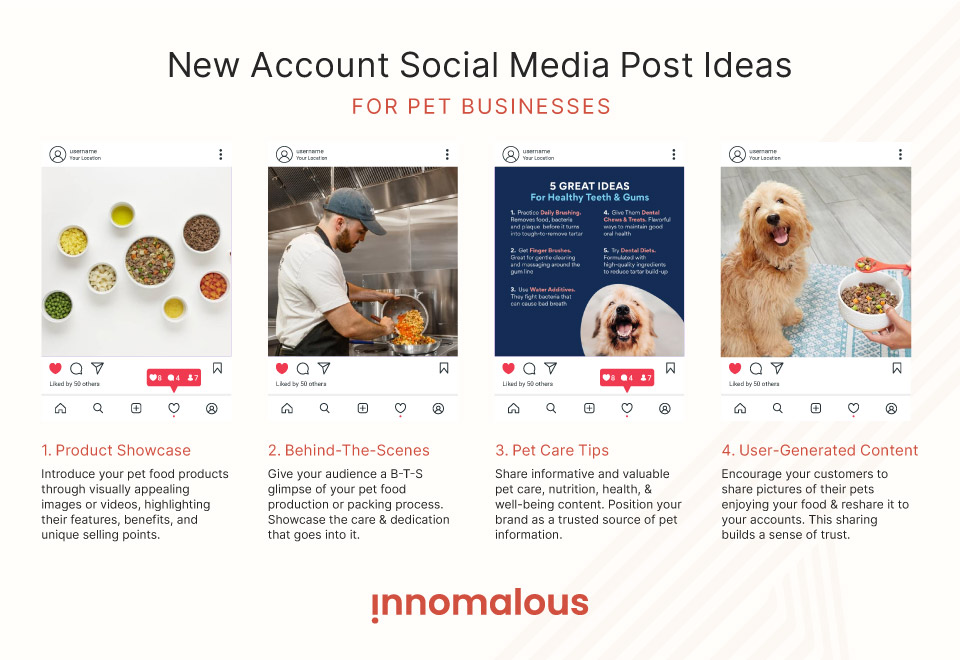
Setting up Email and Phone for Your Indian Pet Food Startup
Effective communication channels enable you to connect with customers, handle inquiries, provide support, and ensure smooth organizational communication. We recommend setting up the following channels when you start.
Email
Emails let you handle customer inquiries, respond to product-related questions, and manage business correspondence. To set up an email for your pet food startup, follow these steps.
Domain and Hosting
Register a domain name for your business and choose a reliable hosting provider that offers email services.
Professional Email Address
Create professional email addresses using your domain (e.g., [email protected], [email protected]).
Email Client
Choose an email client that suits your needs, such as Gmail, Outlook, or a business-specific email service.
Email Signature
Create a consistent and professional email signature that includes your contact information, brand logo, and links to your website or social media accounts.
Phone
Having a dedicated phone line for your pet food startup enables customers to reach you with inquiries. Consider the following steps when setting up a phone line.
Choose a Phone Service Provider
Research and select a phone service provider that offers reliable services and suits your budget and requirements.
Toll-Free or Local Number
Decide whether you want a toll-free or local number based on your target audience and business needs.
VoIP or Traditional Phone System
Explore options like Voice over Internet Protocol (VoIP) systems or traditional phone systems based on your preferences and infrastructure.
Call Routing and Forwarding
Set up call routing and forwarding to ensure calls are directed to the appropriate department or individual within your organization.
Setup IVR
IVR systems use automated voice menus to guide callers to the right department using a predetermined call flow. As your call volume increases, you can consider setting up an IVR system.
As an add-on, you can also set up a WhatsApp or voicemail communication channel for customers to easily leave you messages outside of your working hours.
Effective communication can significantly elevate the customer experience. Streamlining your communication processes ensures smooth interactions with customers and stakeholders the majority of the time.
Step 6: Developing Sales, Marketing & Distribution Strategies
Developing effective strategies to reach your target audience, promote your products, and ensure efficient distribution helps your business start bringing in sales. By aligning your sales, marketing, and distribution efforts, you can maximize visibility, attract customers, and drive sales.
Let us explore the key elements and considerations when developing your sales, marketing, and distribution strategy for your Indian pet food business.
Crafting a Winning Sales Strategy for Your Pet Food Startup
A well-defined sales strategy drives revenue and achieves business growth. It involves planning and executing a set of tactics to effectively promote your pet food products, generate leads, convert prospects into customers, and build lasting relationships.

These are the key steps to developing a sales strategy for your pet food business.
Identify Your Target Market & Customers
Start by identifying your target market and understanding their specific needs, preferences, and buying behaviors. Identify the demographic and psychographic attributes of your ideal customer base.
You could be selling directly to consumers, or to distributors or retail channels. Keeping their unique requirements in mind will guide your sales efforts and help you tailor your approach to effectively reach and engage with your target audience.
Set Sales Goals and Objectives
Clearly define your sales goals and objectives. Whether it is increasing revenue, acquiring new customers, or expanding market share, establish specific, measurable, achievable, relevant, and time-bound (SMART) goals.
Break them down into smaller milestones to track your progress and motivate your sales team.
Build a Strong Sales Team
Assemble a competent and motivated sales team that understands your product offerings, target audience, and sales process. Provide comprehensive product training and equip them with the necessary tools, resources, and sales collateral to effectively communicate the value of your pet food products.
Foster a positive and collaborative sales culture that encourages teamwork and continuous improvement.
Develop a Sales Process
Create a structured sales process that outlines the steps your team will follow to guide prospects through the buying journey. This process includes lead generation, prospecting, qualifying leads, presenting your products, addressing objections, and closing deals.
Define clear roles and responsibilities for each stage and establish key performance indicators (KPIs) to measure success.
Implement Customer Relationship Management (CRM) Software
Invest in a CRM system to streamline your sales activities, track customer interactions, and manage your sales pipeline effectively.
A CRM system allows you to organize customer data, track communication history, automate follow-ups, and generate insightful reports. This setup enables your sales team to prioritize leads, nurture relationships, and maximize sales opportunities.
Create Effective Sales Collateral
Develop compelling sales collateral such as brochures, product catalogs, presentations, and case studies that showcase your product's features, benefits, and unique selling points.
Ensure that your sales collateral is visually appealing, informative, and tailored to address the target audience's needs and pain points.
Establish Pricing and Promotions
Determine competitive and profitable pricing strategies for your pet food products. Take into account elements such as production costs, market demand, competitor pricing, and perceived value when making pricing considerations.
Offer promotions, discounts, or loyalty programs to incentivize customers and create a sense of urgency.
Nurture Customer Relationships
Focus on building strong, long-term relationships with your customers. Provide exceptional customer service, address their concerns promptly, and exceed their expectations.
Regularly communicate with your existing customers to upsell, cross-sell, and gather feedback. Harness the power of customer testimonials and referrals to instill trust and draw in new clientele.
Track and Analyze Sales Performance
Continuously monitor and analyze your sales performance using relevant metrics and key performance indicators (KPIs). Measure factors like conversion rates, average deal size, customer acquisition costs, and sales velocity.
Identify areas of improvement, address bottlenecks, and refine your sales strategies based on data-driven insights.
Stay Updated with Industry Trends
Keep a close eye on industry trends, market dynamics, and emerging technologies in the pet food industry. Stay informed about changing customer preferences, regulatory requirements, and competitor strategies.
Adapt your sales approach accordingly to stay ahead of the competition and capitalize on new opportunities.
Foster Partnerships and Collaborations
Explore strategic partnerships and collaborations with complementary businesses, such as pet stores, veterinarians, or online platforms. This can help you expand your reach, access new customer segments, and leverage existing customer bases.
Develop mutually beneficial relationships to drive mutual growth and customer acquisition.
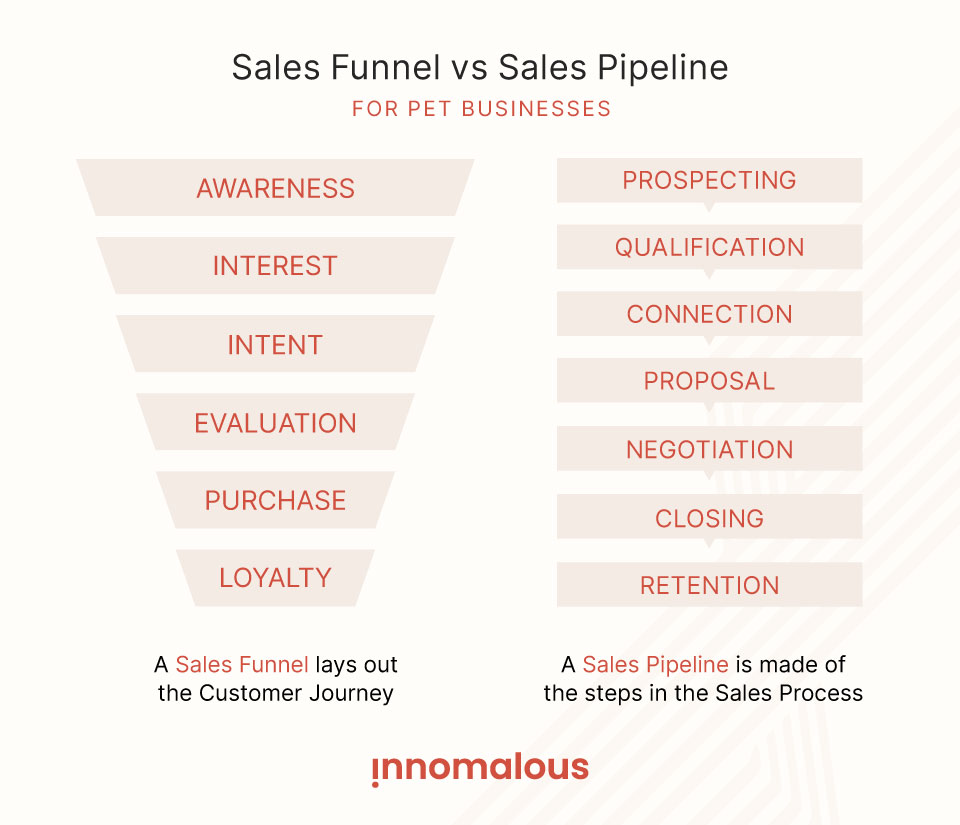
By following these steps and consistently refining your sales strategy, you can effectively drive sales, maximize revenue, and position your pet food business for long-term success. Remember to adapt your approach as market conditions evolve, and always prioritize delivering value to your customers.
Creating a Digital Marketing Strategy That Converts for Your Pet Food Startup
A strong online presence and effective digital marketing strategies are crucial for the success of any business, including pet food startups. A well-crafted digital marketing strategy can help you increase brand awareness, reach your target audience, drive website traffic, and ultimately boost sales.
Here are the key steps to create a comprehensive digital marketing strategy for your Indian pet food business.
Define Your Target Audience
Start by clearly identifying your target audience. Understand their demographics, interests, behaviors, and preferences.
By doing so, you can refine your digital marketing efforts to precisely target and capture your preferred customer demographic.
Set Clear Goals and Objectives
Define your objectives for your digital marketing initiatives.
Whether it is increasing brand awareness, driving website traffic, generating leads, or boosting online sales, clearly define your goals and set measurable objectives to track your progress.
Develop a Strong Brand Identity
Establish a compelling and consistent brand identity that resonates with your target audience. Define your brand's unique selling proposition (USP) and core brand messaging.
Ensure that your brand voice, tone, and visuals are consistent across all digital platforms.
Website Optimization
Optimize your website to ensure it is user-friendly, visually appealing, and search engine optimized (SEO).
Perform comprehensive keyword research and optimize your website's content, meta tags, headings, and URLs. Improve website speed, mobile responsiveness, and user experience to enhance online visibility and user engagement.
Content Marketing
Develop a content marketing strategy to create valuable and relevant content for your target audience. Create engaging blog posts, articles, videos, infographics, and social media content that educate, entertain, and inspire.
Use content to establish your brand as an industry authority and build trust with your audience.
Social Media Marketing
Leverage social media platforms to engage with your audience, share valuable content, and promote your products. Choose the social media platforms that align with your target audience and industry.
Create a content calendar, schedule posts, and engage with followers to build a loyal community.
Paid Advertising
Consider paid advertising platforms such as Google Ads or social media advertising to reach a wider audience. Set a budget, define your target audience, and create compelling ad campaigns that drive traffic and conversions.
Continuously monitor and fine-tune your campaigns to optimize ROI.

Email Marketing
Build an email list and implement email marketing campaigns to nurture leads and engage with your customers. Send your subscribers personalized and relevant content, promotions, and product updates.
Use email automation to streamline your campaigns and track engagement.
Influencer Marketing
Collaborate with pet influencers or industry experts who have a substantial social media following. Partner with them to promote your products and generate brand awareness.
Choose influencers whose audience aligns with your target market to maximize the impact of your influencer campaigns.
Analytics and Measurement
Implement web analytics tools such as Google Analytics to track and measure the performance of your digital marketing efforts. Keep a close watch on essential metrics such as website traffic, conversion rates, email open rates, and social media engagement.
Use the insights to refine your strategies and optimize your campaigns.
Continuous Monitoring and Adaptation
Keep a close eye on your digital marketing campaigns and make adjustments as needed. Stay informed about industry trends, consumer behaviors, and emerging technologies to remain current and competitive.
Continuously test and optimize your strategies to stay ahead of the competition and drive long-term success.
Building a strong digital presence takes time and consistency, so stay committed and focused on providing value to your customers through your digital marketing efforts.
Designing an Offline Marketing Strategy That Boosts Your Pet Food Startup
While digital marketing is crucial in the digital age, offline marketing strategies can also promote your pet food business and help reach potential customers who might not be as active online.
This is our comprehensive guide to developing an effective offline marketing strategy for your Indian pet food business.
Local Events and Sponsorships
Participate in local pet-related events, trade shows, and exhibitions to showcase your products and interact with pet owners directly.
Consider sponsoring pet-related events or community initiatives to increase brand visibility and demonstrate your commitment to the pet community- if budgets allow.
Print Advertising
Utilize print advertising in local newspapers, pet magazines, and pet-related publications to reach a broader local audience. Advertise strategically, highlighting your unique selling points and special offers.
Consider distributing flyers and brochures at pet stores, veterinary clinics, and grooming salons.
Pet Store Promotions
Collaborate with pet stores to run joint promotions and offer discounts or product bundling deals. Provide in-store displays and demos to attract pet owners' attention and encourage trial purchases.
Offer promotional packages for new pet owners or those looking to switch pet food brands or find new treats and supplements.
Product Sampling
Conduct product sampling activities at pet events, pet stores, and public spaces with high pet footfall.
Offering free samples allows pet owners to taste-test your products and experience their quality firsthand, increasing the likelihood of future purchases.
Vehicle Branding
Brand your company vehicles with your pet food business's logo, website, and contact information.
This mobile advertising can raise awareness and increase brand visibility as you travel to different locations.
Billboard Advertising
Consider placing billboards strategically in high-traffic areas or near pet-related locations.
Keep the messaging simple, eye-catching, and memorable to leave a lasting impression on passersby.
Pet-Friendly Partnerships
Collaborate with pet-friendly cafes, parks, or pet grooming salons to promote your brand.
Offer special discounts or coupons to customers who visit these partner establishments, creating a mutually beneficial relationship.
Pet-Focused Workshops and Seminars
Organize workshops or seminars on pet nutrition, health, or training, positioning yourself as an authority in the pet food industry.

Use these events to educate pet owners about the importance of high-quality pet food and the benefits of your products.
Community Engagement
Get involved in community initiatives and charitable activities related to pets. Support local animal shelters or pet rescue organizations to show your commitment to animal welfare.
These efforts not only contribute to the community but also create positive associations with your brand.
An effective offline marketing strategy complements your digital efforts and enhances your overall brand presence. By combining both online and offline initiatives, you can reach a diverse audience, establish a strong brand identity, and foster customer loyalty in the Indian pet food market.
Implementing a Successful Online and Offline Product Distribution Strategy for Your Pet Food Business
A well-designed product distribution strategy ensures that your pet food products reach your target customers efficiently and effectively. This strategy involves determining the most suitable distribution channels, optimizing inventory management, and establishing strong partnerships with distributors and retailers.
This is how you can create an integrated online and offline product distribution strategy for your Indian pet food business.
Identify Distribution Channels
Start by identifying the most suitable distribution channels for your pet food products. Consider both online and offline options, such as e-commerce platforms, pet stores, supermarkets, veterinary clinics, and specialty pet shops.
Each channel may cater to different customer segments, so tailor your approach accordingly.
E-commerce Platforms
Embrace the power of e-commerce platforms to reach a broader audience beyond your local market. Partner with established online marketplaces and set up your e-commerce website.
Explore popular marketplaces in India like Amazon, Flipkart, Nykaa, et cetera. Also consider quick-commerce services like BigBasket, Dunzo, Swiggy Instamart, Milk Basket, et cetera.
Partnering with Pet Stores and Supermarkets
Collaborate with pet stores, supermarkets, and retail chains to stock your pet food products. Develop strong relationships with store owners or managers to secure prominent shelf space and ensure regular replenishment of your products.
You can also choose to work with Indian pet-specific marketplaces like Heads Up For Tails, Petsy, SuperTails, et cetera.
Veterinary Clinics and Grooming Salons
Consider partnering with veterinary clinics and grooming salons to offer your pet food products to pet owners seeking professional recommendations.
Provide product samples or educational materials for veterinarians and groomers to share with their clients.
Distributor and Wholesaler Partnerships
Form strategic partnerships with distributors and wholesalers to expand your market reach and tap into your existing network of retailers. Distributors can help you reach regional or national markets efficiently.
Dropshipping
Explore dropshipping partnerships with e-commerce platforms or retailers. With drop shipping, you can fulfill orders directly from your manufacturing facility or warehouse, reducing inventory management complexities.
Inventory Management
Implement a robust inventory management system to optimize stock levels and prevent stockouts or overstock situations. Use sales data and demand forecasting to ensure timely restocking and minimize holding costs.
Brand Presence and Merchandising
Invest in eye-catching packaging and in-store displays to enhance your brand presence and attract customer attention. Ensure that your pet food products are well-organized and visually appealing on store shelves.

Customer Support and Training
Provide training and product knowledge resources to retailers and distributors to ensure they can effectively promote and sell your pet food products. Offer prompt customer support to address any inquiries or issues that may arise.
Online Advertising and Promotion
Utilize online advertising and promotion strategies offered by e-commerce marketplaces. Strategic paid marketing on e-commerce platforms can help your brand stand out and get in front of audiences easier.
Geotargeting and Local Marketing
Use geotargeting techniques to promote your products to specific geographic locations or target areas. Tailor your marketing messages and offers based on the local preferences and pet owner needs in different regions.
Analyze and Optimize Performance
Continuously monitor the performance of your distribution channels, analyzing factors such as sales volume, customer feedback, and market trends. Use this data to optimize your distribution strategy, focusing on channels that deliver the highest return on investment (ROI).
Customer Feedback and Reviews
Encourage customers to provide feedback and reviews on your products and their buying experience. Positive reviews can boost your brand's reputation, while constructive feedback helps you identify areas for improvement.
Expand Market Reach Gradually
While it is essential to have a presence in multiple distribution channels, consider expanding your market reach gradually. Start with a focused approach in specific regions or cities and expand strategically based on demand and performance.
An effective distribution strategy can make sure your pet food products are readily available to pet owners across India, maximizing market penetration and driving business growth.
Flexibility and adaptability are key in this dynamic market, so be prepared to adjust your strategy based on changing customer preferences and industry trends.
Scaling and Growing Your Pet Food Business in India
As your small pet food business gains traction, the prospect of scaling to greater heights becomes increasingly alluring. However, this transformative journey requires more than just ambition; it demands a well-thought-out and intentional plan.
Scaling a medium or large pet food business is no easy feat either. As your business grows, so does the impact of every decision you make. This perception of risk can easily put medium-to-large businesses in a state of paralysis leading to missed growth opportunities and potential revenue-loss.
Scaling a business involves navigating complexities, making critical decisions, and managing resources judiciously. In this section, we delve into the significance of crafting a strategic plan before embarking on the scaling process.
Drafting an effective expansion plan is a two-step process, a thorough analysis of your brand and company, followed by putting down an actionable plan that ensures every stride taken aligns with your long-term vision.
Step 1: Conduct a Thorough Brand & Company Analysis
An exhaustive analysis of the present offers invaluable insight that you can use to create your plan for the future.
In this step, we suggest analyzing your brand and company to find any loopholes, weaknesses, and missed opportunities. The goal is to assess your business’s readiness for scaling and becoming better equipped to formulate a successful strategy.
Your analysis should involve an inspection of these characteristics. Feel free to add more avenues you need to incorporate depending on the specifics of your business.
Customer Response and Reviews
Analyze customer feedback and reviews about your pet food products. Pay attention to both positive and negative reviews to understand customer preferences, pain points, and suggestions for enhancement.
Product Performance
Evaluate the performance of your pet food products in terms of sales, popularity, and customer satisfaction. Identify your best-selling products and those that might need improvement or modifications.
Repeat Order Rate
Calculate the percentage of customers who make repeat purchases. A high repeat order rate indicates customer loyalty and satisfaction with your products.
Product Margins
Examine the profitability of each product in your lineup. Identify products with higher profit margins that contribute significantly to your revenue.
Customer Acquisition Cost
Determine the cost of acquiring each new customer. This metric provides insight into the effectiveness of your marketing and sales endeavors.
Marketing Spend RoI (Return on Investment)
Assess the effectiveness of your marketing campaigns by comparing the cost of your marketing activities to the revenue generated from those activities.

Technology Infrastructure
Evaluate your current technological capabilities and systems. Determine if your IT infrastructure can handle increased demands as your business scales.
Supply Chain Management
Assess your supply chain processes, including sourcing of raw materials and components, manufacturing, and distribution. Is your supply chain robust enough to handle increased production and distribution requirements?
Financial Health
Review your financial statements and assess the overall health of your company's finances. Through this, you can ensure sufficient working capital to support scaling efforts and consider potential funding sources if needed.
Customer Base and Segmentation
Analyze your current customer base and their demographics. Identify potential customer segments that you can target as you scale.
Intellectual Property Protection
If you have developed proprietary recipes, formulations, or technologies, ensure that they are adequately protected through patents or trademarks to safeguard your innovations.
Competitive Landscape
Conduct a thorough analysis of your competitors. Understand their strengths, weaknesses, and market positioning. This information can guide your strategic decisions and help you differentiate your offerings.
Scalability of Operations
Evaluate the scalability of your operations. Consider if your manufacturing processes, distribution networks, and workforce can accommodate increased demand without compromising quality.
Skill Gap Analysis
Evaluate the skill sets of your current team members. Identify any skill gaps that could hinder scaling efforts. Consider whether additional training, hiring, or outsourcing is needed to bridge these gaps effectively.
Cross-Functional Collaboration
Assess the level of collaboration and communication between different departments or teams within your business. Identify opportunities to foster cross-functional cooperation, which can lead to more efficient processes and better decision-making.
Environmental Sustainability
Assess your business's environmental impact and sustainability practices. As you scale, consider how you can maintain or enhance your commitment to eco-friendly practices.
Risk Assessment
Identify potential risks associated with scaling, such as market fluctuations, supply chain disruptions, or changes in consumer preferences so you can develop contingency plans to mitigate these risks.
Analyze this information to notice any patterns, improvement areas, growth opportunities, et cetera. This information is vital when making an action plan that works for your business and leads to sure growth.
You can conduct such an analysis at planned intervals like once a quarter or annually, to observe your business’ progress. This habit can quantify performance and simplify decision-making in your day-to-day business activities.
Step 2: Make an Actionable Plan From the Insights
The insights collected in the last step will form the basis of your action plan to scale your pet food business. You can consider these ideas as a launchpad or checklist to start making a custom plan specific to your business needs and goals.

Fixing Current Challenges and Overcoming Weaknesses
Addressing existing pain points and inefficiencies within your operations can create a stronger foundation for growth.
Identify bottlenecks in your production, distribution, marketing, or customer service processes and implement solutions to streamline these areas.
Hiring Team Members, Upskilling, or Outsourcing Tasks
As your business expands, consider augmenting your team with new hires possessing the expertise required for scaling. Additionally, upskilling your existing team members can empower them to take on new challenges.
Outsourcing specific tasks such as logistics, customer support, or digital marketing can also free up your internal team to focus on core activities.
Improving Product Reach and Exploring Export Opportunities
Explore ways to reach a broader customer base. This could involve expanding your geographic reach by entering new markets and even exploring the potential of exporting your products to international markets.
Research target markets, navigate regulatory requirements, and establish partnerships to enter new territories.
Finding Alternate Marketing Channels
Look beyond your current marketing channels and experiment with new ones. This could involve collaborations with influencers, content partnerships, or even participating in industry events and trade shows.
Revisiting Channel Margins
Reevaluate your pricing and margin structure across different sales channels. Strategically adjusting margins can help you balance profitability and affordability, making your products more appealing to both customers and retailers.
Introducing New Complementary Products
Enhance your product portfolio by introducing complementary items that align with your brand and cater to your target audience. This could include supplementary or novel pet food items, pet accessories, supplements, or even educational content on pet care.
Restrategizing Fund Allocation
Evaluate your budget allocation and consider shifting resources towards areas that will drive the most value during scaling. This might involve increasing marketing spend, investing in new equipment, or expanding your distribution network.
Leveraging Technology and Automation
Embrace technology solutions that can automate repetitive tasks, improve efficiency, and enhance customer experience. This might include inventory management software, customer relationship management (CRM) tools, or even AI-driven customer support.
Enhancing Customer Engagement
Foster deeper connections with your customer base through personalized interactions. Implement loyalty programs, referral incentives, and frequent communication to keep customers engaged and coming back.
Strategic Partnerships
Collaborate with other businesses and influencers in the pet industry to leverage each other's customer bases and strengths. This could involve co-branded promotions, joint product offerings, or cross-promotional campaigns.
Adapting to New Trends
Stay attuned to emerging trends in the pet food industry and adapt your offerings accordingly. This might involve incorporating new ingredients, catering to specific dietary requirements, or aligning with sustainability trends.
Customer Feedback Integration
Leverage customer feedback to refine your products and services. Actively seek customer input and use it to drive product innovation and improvements.
Investing in Branding and Marketing
Devote resources to enhance your brand's visibility and recognition. This could involve revamping your branding, improving packaging aesthetics, and investing in impactful marketing campaigns.
By combining these ideas with a strategic mindset, you can develop a well-rounded approach to scaling your pet food business, fostering growth while navigating the challenges that come with expansion.
Formulating a Winning Pet Food Business Plan + Free Downloadable Sample Template
A well-crafted business plan is a compass that guides your pet food business toward success. It is a roadmap that outlines your vision, strategies, and objectives in a comprehensive and structured manner.
This is our step-by-step guide to creating a winning pet food business plan:
Executive Summary
Start with a concise business overview, highlighting your mission, products, target market, and unique value proposition. This section provides a snapshot of your entire plan.
Business Description
Detail the nature of your pet food business, including your company history, legal structure, and location. Explain your brand story and evolution, emphasizing the factors that set your products apart.
Market Analysis
Conduct a thorough analysis of the pet food industry, including trends, market size, growth potential, and key competitors. Identify gaps in the market that your business aims to address.
Products and Services
Describe your pet food products in detail, including ingredients, nutritional benefits, and unique selling points. If you offer additional services such as subscription models or personalized packaging, outline those too.
Target Audience
Define your ideal customer profile, considering pet type, age, lifestyle, and preferences. Explain how your products cater to their needs and desires.
Marketing and Sales Strategies
Detail your strategies for promoting and selling your products. Detail your digital marketing strategies, offline promotional activities, and sales channels. Include pricing strategies and any discounts or loyalty programs.
Competitive Analysis
Provide an overview of your competitors, their strengths, weaknesses, and market positioning. Highlight what sets your products apart and your strategy for gaining a competitive edge.
Operational Plan
Describe the day-to-day operations of your business, from sourcing products to packaging and distribution. Detail your supply chain management, quality control measures, and processes.
Team Structure
Introduce the core members of your team along with their respective roles. Outline skill or expertise gaps essential to support your business's growth and how you plan to fill them.
Financial Projections
Provide financial projections for the upcoming three to five years, including estimated revenue, expenditures, profits, and cash flow. This section demonstrates the financial viability of your scaling plans.
Funding Requirements
If you are seeking external funding, specify how much capital you need and how you intend to use it. This plan could include production expansion, marketing campaigns, or team expansion.
Risk Analysis and Mitigation
Identify potential risks that could impact your business's growth. Explain how you plan to mitigate these risks and adapt to unforeseen challenges.
Implementation Timeline
Create a timeline that outlines the key milestones and deadlines for executing your scaling strategies. This draft provides a clear roadmap for implementation.
Exit Strategy
If applicable, describe your long-term goals for the business. This strategy could involve a potential exit through acquisition or merger.

Download Free Editable Pet Foods Business Plan Template
Download and edit this free template to quickly create a compelling business plan for your pet food business.
A winning pet food business plan combines a strategic vision with detailed execution plans. Regularly review and adjust your plan as your business evolves, ensuring it remains aligned with your goals and market dynamics.
With a solid business plan in hand, you are better equipped to navigate the complexities of scaling your pet food business successfully.
9 Common Challenges Pet Food Businesses Face and Suggested Solutions
The pet food industry presents both promising opportunities and unique challenges. These are some common challenges that pet food businesses often encounter and effective solutions to overcome them.
Quality Control and Ingredient Sourcing
Challenge: Ensuring consistent quality and sourcing reliable ingredients can be challenging, especially as you scale.
Solution: Partner with trusted suppliers and manufacturers with a proven track record. Innomalous, as a premium natural pet food manufacturer, offers a reliable solution for sourcing high-quality ingredients and manufacturing excellence.
Intense Competition
Challenge: The pet food market is competitive, making it crucial to stand out.
Solution: Differentiate your brand by focusing on unique value propositions. Innomalous can assist in crafting exceptional, premium-quality pet food products that set your brand apart.
Customer Education
Challenge: Educating pet owners about the benefits of your products requires effective communication.
Solution: Develop informative content, such as blog posts or social media campaigns, and YouTube videos highlighting the nutritional advantages of your products.
Scaling Challenges
Challenge: Scaling your operations without compromising quality can be challenging.
Solution: Collaborate with manufacturers experienced in scaling production while maintaining product integrity. Innomalous can support your scaling journey while ensuring quality consistency.
Marketing and Branding
Challenge: Establishing a strong brand presence and effective marketing strategies is essential.
Solution: Craft a compelling brand identity and leverage digital marketing channels. Innomalous’ add-on services like packaging design and product photography help its clients elevate their marketing efforts.
Customer Loyalty
Challenge: Building and retaining a loyal customer base can be difficult in a competitive market.
Solution: Focus on exceptional customer service, personalized experiences, and loyalty programs. Ensure top-notch product quality as a strong product is at the heart of a great customer experience and long-term loyalty.
Distribution Logistics
Challenge: Efficiently distributing products while minimizing costs can be complex.
Solution: Optimize your distribution network and consider partnerships with established retailers. Choose your retail locations strategically to make the most out of limited reach.
Sustainability Concerns
Challenge: Addressing environmental concerns and adopting sustainable practices is increasingly important.
Solution: Incorporate eco-friendly packaging and transparent sourcing practices. Partnering with an eco-conscious manufacturer ensures you consider sustainability right at the root. Innomalous is committed to sustainability, aligning with your values for a better future for our pets.
Inventory Management
Challenge: Balancing supply and demand to avoid overstocking or stockouts.
Solution: Implement robust inventory management systems to track sales trends and adjust production accordingly. Innomalous helps its clients project order timelines for timely restocking and cost optimization based on market trends.
Navigating these challenges requires combining industry knowledge, strategic planning, and reliable partners. Innomalous, with its expertise in premium pet food production, can be a valuable partner in overcoming these obstacles and achieving success in the dynamic pet food market.
Staying Relevant in the Ever-Evolving Pet Food Industry: Strategies for Long-Term Success
In the fast-paced world of the pet food industry, staying relevant is paramount to sustained success. The preferences of pet owners, market trends, and consumer behaviors are constantly changing.

These are key strategies to ensure your pet food business remains pertinent and competitive in the Indian market.
Continuous Innovation
Embrace innovation as a foundational value of your business. Strategically introduce new flavors, formats, and ingredients to your product lineup. This dynamism keeps your offerings exciting and relevant, appealing to the evolving tastes of pet owners.
Consumer-Centric Approach
Keep your finger on your target audience's pulse of preferences and needs. Interact with your customers through surveys, feedback forms, and engagements on social media platforms. This valuable insight can drive product development and improve customer experience.
Quality and Transparency
Maintain a commitment to quality products and transparent sourcing. Consumers today are increasingly conscious about what they feed their pets. Highlight your quality standards and ingredient lists to build trust.
Health and Wellness Focus
Leverage the growing interest in pet health and wellness. Develop products that address specific dietary needs, such as weight management, digestive health, or allergies. Position your brand as a partner in the well-being of pets.
Sustainable Practices
Incorporate sustainable practices into your business operations. From eco-friendly packaging to responsible sourcing, demonstrating a commitment to environmental stewardship can resonate with conscious consumers.
Digital Engagement
Leverage digital platforms to engage with your audience. Maintain an active presence on social media, sharing informative content about pet care, nutrition, and lifestyle. Engage with your customers in a meaningful way to foster brand loyalty.
Collaboration and Partnerships
Collaborate with other businesses in the pet industry, such as pet supply stores, grooming salons, or veterinarians. Cross-promotions and partnerships can expand your reach and introduce your products to new audiences.
Anticipating Trends
Stay ahead of emerging trends in pet nutrition, packaging, and consumer behavior. Whether it is plant-based diets, customized nutrition plans, or new packaging formats, being an early adopter can set you apart.
Responsive Customer Service
Prioritize excellent customer service. Respond promptly to inquiries, address concerns, and resolve issues with empathy. A positive customer service experience can lead to long-term loyalty.
Data-Driven Decision Making
Utilize data analytics to understand customer behaviors, preferences, and purchase patterns. This data-driven approach can guide your product development and marketing strategies.
Adaptability to Cultural Shifts
The Indian pet culture is evolving rapidly. Stay attuned to cultural shifts and societal changes that influence pet ownership and pet care preferences.
Staying relevant requires a deep understanding of your market, a willingness to embrace change, and an unwavering commitment to meeting the evolving needs of pet owners. By implementing these strategies, your pet food business can stay relevant and thrive in the dynamic and competitive Indian pet food industry.
Expanding Your Pet Business: Adding a Pet Food Range for Enhanced Success
For pet business owners already immersed in the world of pet grooming, accessories, boarding, training, veterinary, or other related products and services, venturing into the realm of pet food can be a strategic move.
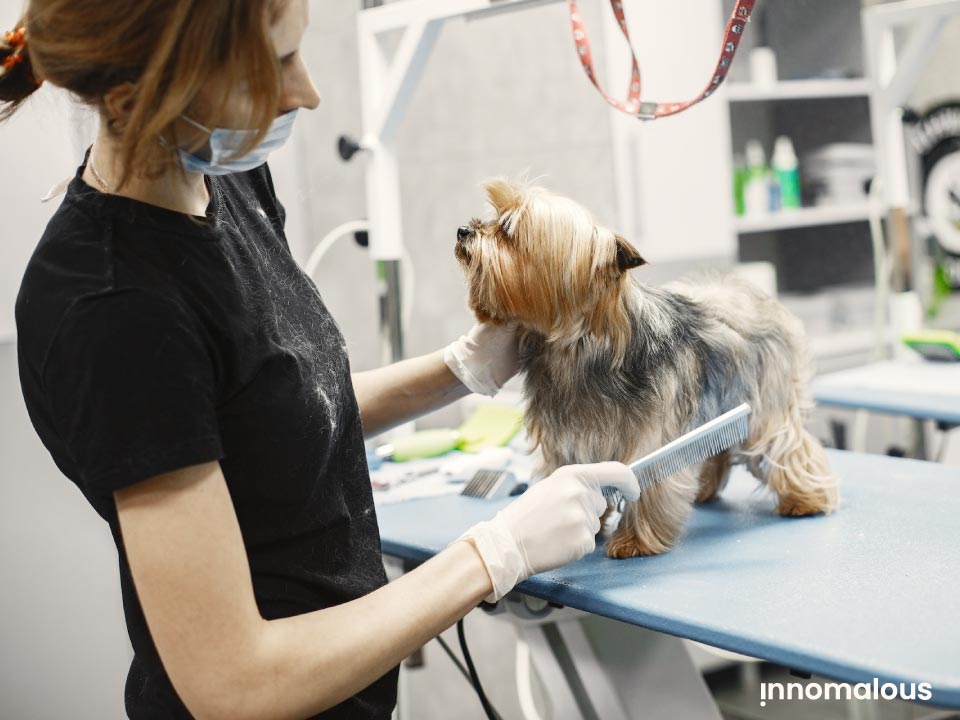
Adding a pet food range to your existing offerings not only diversifies your business but also taps into a lucrative market segment. Here is why you should consider this expansion.
Why Add a Pet Food Range to Your Existing Pet Business
Comprehensive Pet Care
Offering pet food alongside your existing services creates a one-stop shop for pet owners. They can access grooming, accessories, and now nutrition, all in one place.
Customer Loyalty
A pet food range builds stronger customer relationships. Your clients are likely to trust a brand they already know and love for other pet-related needs.
Increased Revenue Streams
Expanding your offerings means new revenue streams. Pet food, particularly premium and natural options, can provide consistent sales and recurring income.
Cross-Selling Opportunities
Cross-promotion between your existing services and the new pet food range can lead to increased sales across all areas of your business.
Enhanced Brand Credibility
A diversified business showcases your commitment to comprehensive pet care. This can enhance your brand's credibility and authority.
How Innomalous Facilitates Your Pet Food Launch
Innomalous, as a contemporary pet food manufacturer, empowers your entrepreneurial journey toward success by offering the following acceleration avenues.
Low Capital Investment
While entering the lucrative pet food industry holds immense potential, establishing a pet food manufacturing unit demands substantial investment and specialized expertise. The resource-intensive nature of this setup can prove daunting for budding businesses.
Innomalous offers an expedited entry into the pet food sector by providing startup-friendly Minimum Order Quantities without lengthy commitments.
Higher Product Margins
Natural pet food brands often grapple with a pricing dilemma. Premium-quality raw materials come at a cost, but pricing products at significantly elevated rates can hinder market acceptance. On the other hand, aligning prices with subpar competition can erode profit margins.
Innomalous adeptly addresses this challenge by streamlining sourcing, production, and logistics, ensuring clients access competitive and transparent pricing for optimized profits.
Superior Palatability & Efficacy
Rejecting harmful synthetic taste enhancers, palatants, and MSG is a commitment that often results in the compromised palatability of many natural pet foods.
Innomalous' dedicated R&D team meticulously crafts foods boasting of not only innately high palatability but also noticeable enhancements in pet health.
Reliable Product Consistency
Ensuring that responsibly sourced natural ingredients yield consistent results over time is paramount to presenting truly market-ready products.
Harnessing AI-powered technology empowers Innomalous to maintain unwavering quality, palatability, attributes, and shelf life in its product range.
Extended Shelf-Life
The challenge of limited shelf life has long hindered the scalability of natural pet foods. Innomalous employs advanced moisture control technology to consistently achieve extended shelf life without resorting to added preservatives.
Informed, Intelligent, and Integrated Manufacturing
Pet food manufacturers play a pivotal role in the pet industry's foundation, influencing trends and growth trajectories. Innomalous takes this responsibility to heart, investing in continuous education spanning pet health, food processing, sustainability, and global pet industry dynamics.
The team regularly introduces new products to help brands remain at the forefront and prosper, all while delivering utmost value to their customers.
Adding a pet food range to your existing pet business is a strategic move that can elevate your brand and offer enhanced value to your customers. Partnering with Innomalous ensures a smooth and efficient launch process, setting you on the path to success in the competitive pet industry.
Conclusion
In the dynamic world of pet food businesses, the journey from inception to expansion is a rewarding one, filled with challenges and opportunities.
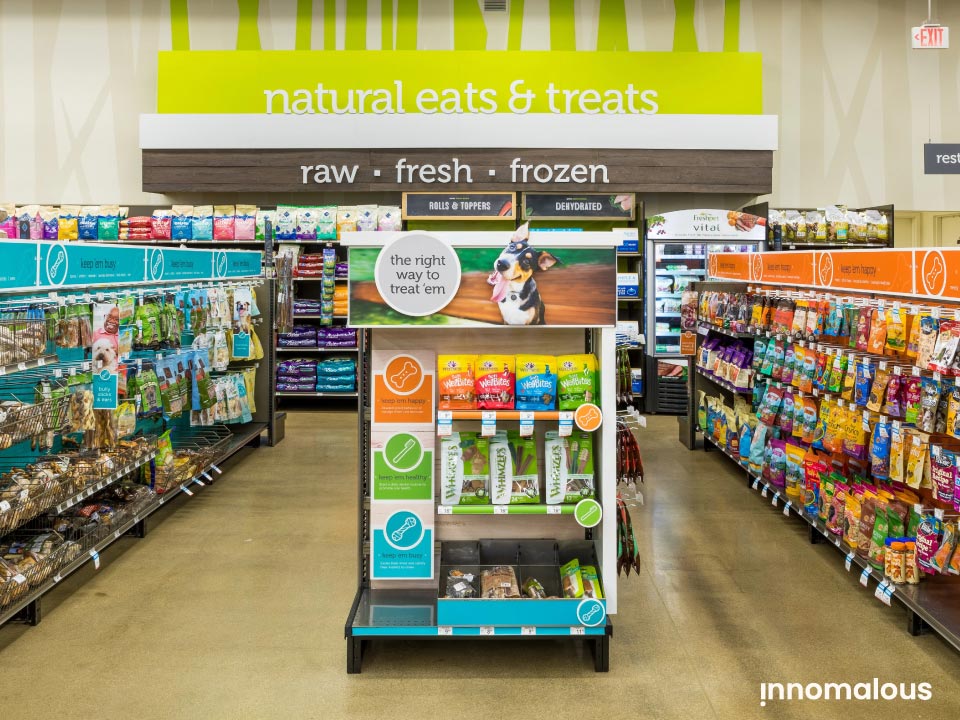
This comprehensive guide has illuminated every aspect of starting, scaling, and thriving in the Indian pet food market. From understanding industry trends and market demands to crafting a compelling brand identity, from developing quality products to strategizing sales and marketing, every step has been meticulously explored.
With the right knowledge, resources, and partners like Innomalous, you're equipped to navigate the pet food industry with confidence.
As you embark on this exciting journey, remember that your dedication to pet health, innovation, and customer satisfaction will be the driving force behind your pet food business's success.
Your journey is one where each nutritious bite you offer contributes not only to the health of pets but also to the aspirations of driven entrepreneurs like you.
Ready to embark on this path to success? Partner with Innomalous today and let's begin crafting your thriving pet food business together!




